School Energy Experts Teacher Guide
Hands-on activities that introduce students to the ways in which we use energy in school buildings. The school becomes a living laboratory as students explore thermal energy transfer, electricity, lighting, and even conduct their own building audit.
2024-2025



Grade








Science
Level: Subject Areas: Language Arts Intermediate Pri Ele Int Sec Math Social Studies
Technology
OFF
Teacher Advisor y Board
Constance Beatty Kankakee, IL
La’Shree Branch Highland, IN
Jim M. Brown Saratoga Springs, NY
Mark Case Randleman, NC
Lisa Cephas Philadelphia, PA
Nina Corley Galveston, TX
Samantha Danielli Vienna, VA
Shannon Donovan Greene, RI
Michelle Garlick Long Grove, IL
Michelle Gay Daphne, AL
Nancy Gi ord Harwich, MA
Erin Gockel Farmington, NM
Robert Griegoliet Naperville, IL
DaNel Hogan Tucson, AZ
Greg Holman Paradise, CA
Barbara Lazar Albuquerque, NM
Robert Lazar Albuquerque, NM
Melissa McDonald Gaithersburg, MD
Paula Miller Philadelphia, PA
Hallie Mills St. Peters, MO
Jennifer MitchellWinterbottom Pottstown, PA
Monette Mottenon Montgomery, AL
Mollie Mukhamedov Port St. Lucie, FL
Cori Nelson Win eld, IL
Don Pruett Jr. Puyallup, WA
Judy Reeves Lake Charles, LA
Libby Robertson Chicago, IL
Amy Schott Raleigh, NC
Tom Spencer Chesapeake, VA
Jennifer Trochez MacLean Los Angeles, CA
Wayne Yonkelowitz Fayetteville, WV
NEED Mission Statement
The mission of The NEED Project is to promote an energy conscious and educated society by creating effective networks of students, educators, business, government and community leaders to design and deliver objective, multi-sided energy education programs.
Permission to Copy
NEED curriculum is available for reproduction by classroom teachers only. NEED curriculum may only be reproduced for use outside the classroom setting when express written permission is obtained in advance from The NEED Project. Permission for use can be obtained by contacting info@need.org.
Teacher Advisory Board
In support of NEED, the national Teacher Advisory Board (TAB) is dedicated to developing and promoting standardsbased energy curriculum and training.
Energy Data Used in NEED Materials
NEED believes in providing teachers and students with the most recently reported, available, and accurate energy data. Most statistics and data contained within this guide are derived from the U.S. Energy Information Administration. Data is compiled and updated annually where available. Where annual updates are not available, the most current, complete data year available at the time of updates is accessed and printed in NEED materials. To further research energy data, visit the EIA website at www.eia.gov.

2 ©2024 The NEED Project School Energy Experts Teacher Guide www.NEED.org Printed
Paper
on Recycled
1.800.875.5029 www.NEED.org © 2024
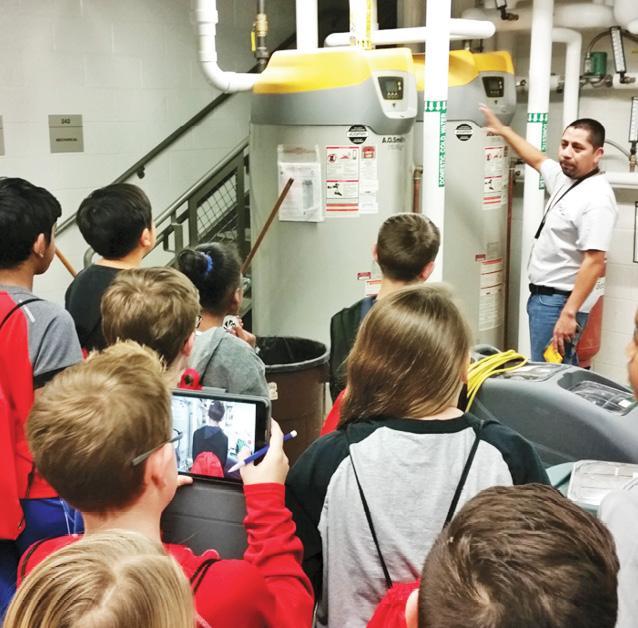
School Energy Experts Kit
1 Light emitting diode bulb (LED)
1 Kill A Watt® meter
5 Sets of radiation cans (2 per set)
10 Lab thermometers
2 Bags of insulating materials (cellulose, packing peanuts)
5 Boxes
1
1
School Energy Experts
Table of Contents

©2024 The NEED Project School Energy Experts Teacher Guide www.NEED.org 3
3 Student thermometers
Light meter
digital thermometer
1 Waterproof
Digital humidity/temperature pen
(hygrometer)
1 9-volt Battery (for light meter)
1 Infrared (IR) thermometer
1 Teacher Guide 1 Student Guide
Standards Correlation Information 4 Materials 5 Teacher Guide 6 Lesson 1 7 Lesson 2 8 Lesson 3 11 Lesson 4 12 Lesson 5 14 Lesson 6 15 Assessment and Evaluation 18 Answer Keys 19 Energy Efficiency Bingo Instructions 21 Conservation in the Round 23 Baseload Balance 24 Student Information 27 Generation Parameters 29 Hang Tag Template 30 Incident Cards 36 Cheat Sheet 37 Student Worksheet 38 Masters Forms of Energy 40 U.S. Energy Consumption by Source, 2022 41 Thermometer 42 Infrared Thermometer Master 43 Transporting Electricity 44 Kill A Watt® Meter 45 The Light Meter 46 Digital Thermometer 47 Hygrometer 48 Energy Efficiency Bingo 49 Conservation in the Round Cards 50 Evaluation Form 55 OFF
Standards Correlation Information
www.need.org/educators/curriculum-correlations
Next Generation Science Standards
This guide effectively supports many Next Generation Science Standards. This material can satisfy performance expectations, science and engineering practices, disciplinary core ideas, and cross cutting concepts within your required curriculum. For more details on these correlations, please visit NEED’s curriculum correlations website.
Common Core State Standards
This guide has been correlated to the Common Core State Standards in both language arts and mathematics. These correlations are broken down by grade level and guide title, and can be downloaded as a spreadsheet from the NEED curriculum correlations website.
Individual State Science Standards
This guide has been correlated to each state’s individual science standards. These correlations are broken down by grade level and guide title, and can be downloaded as a spreadsheet from the NEED website.
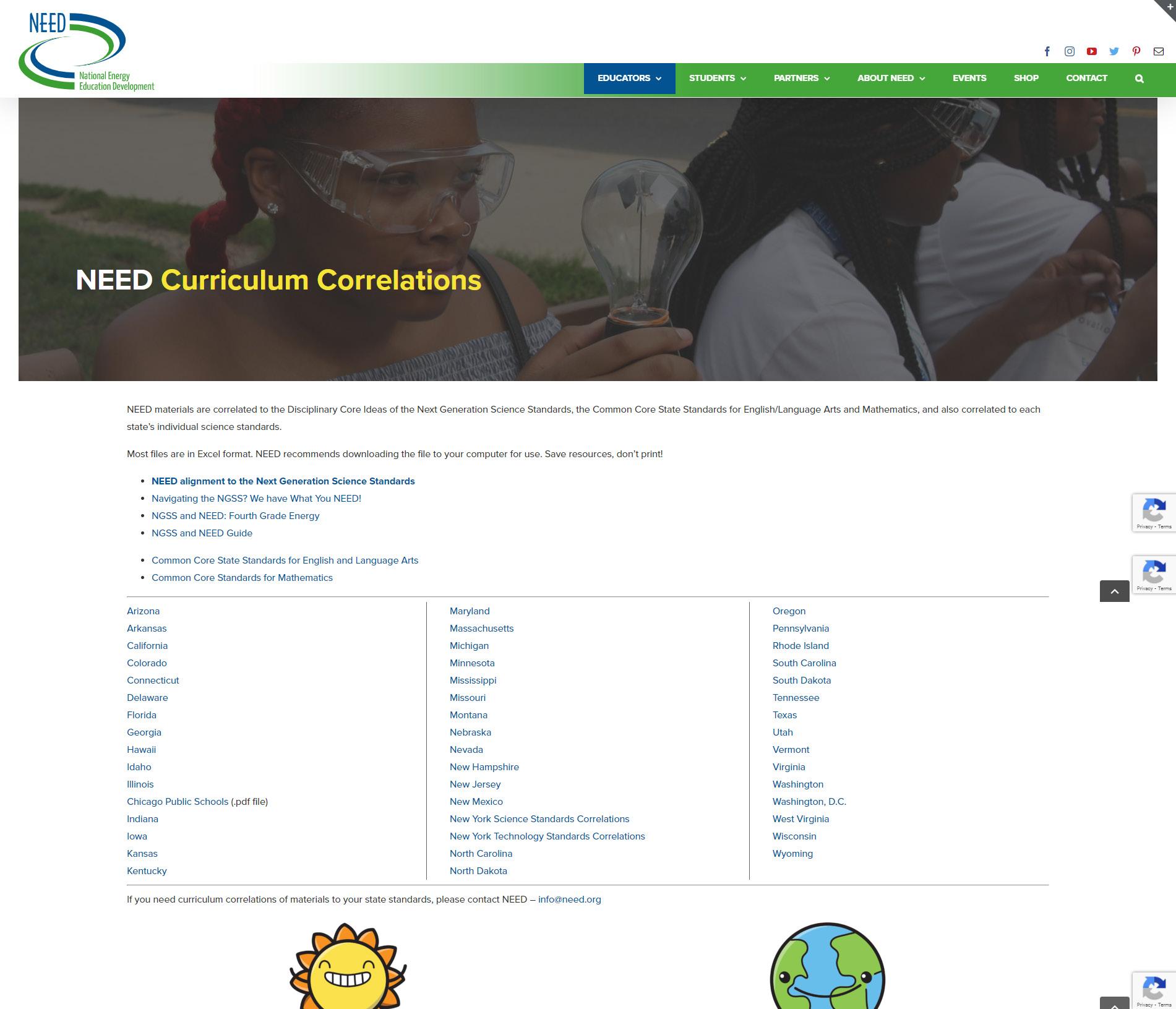
4 Teacher Guide www.NEED.org

School Energy Experts Materials
Conduction, Convection, Radiation
Demonstration
Radiation
Insulation Investigation
2
Air Infiltration Investigation
3
Infrared (IR) thermometer
Radiation Cans
Small boxes
Insulation materials (cellulose, packing peanuts)
Lab thermometers
Plastic zip-close bags
Measuring Electricity Use and its Cost Kill A Watt® meter
Understanding Electrical Utility Bills
Light Bulb Investigations
Keeping the Lights On
LESSON 4
Student Audits
LESSON 6
Student thermometers
LED Bulb
Kill A Watt® meter
Light meter
Digital thermometer
Hygrometer
Light meter
Kill A Watt® meter
Infared Thermometer
Several sheets of scrap paper
Large buckets, bins, or boxes
Other insulation materials as are safe and appropriate, such as fiberglass fill
Rubber bands
Spray can expandable foam insulation
Hot water
Tape
Thick rubber or work gloves
Respirator masks
Tissue paper
Pencils
Tape
Electrical devices for investigation
Calculators (optional)
Copies of school electric bills
1-2 Lamps
Incandescent bulb
Tape
Ruler or meter stick
Calculators (optional)
Clipboards or folders
Need extra insulation materials? Head to NEED.org/shop and pick up a School Energy Experts consumables pack.
*NOTE: Handle all insulation with caution. Use masks, gloves, and eye protection to minimize fiber and skin contact.
©2024 The NEED Project School Energy Experts Teacher Guide www.NEED.org 5
LESSON ACTIVITY MATERIALS IN KIT ADDITIONAL MATERIALS NEEDED
LESSON
LESSON
OFF

Grade Level
Teacher Guide
Intermediate, grades 6-8
Time
10 -14 class periods or less depending on the activities selected and in-class and out-ofclass time used.
& I ntroduction
School Energy Experts is designed to be the classroom education component of a total energy management plan for intermediate schools. An energy management plan could also include training of the building manager, administrators, and maintenance staff, and retrofitting the building. The activities in this unit have been designed in a series of lessons to build on one another, providing all of the information students need to conduct a student energy audit of the building, and understand building operation.
Home Kit
Managing Home Energy Use is an at-home supplement to the energy consumption activities in this guide. Managing Home Energy Use follows the same format as this guide and expands on the efficiency and conservation knowledge gained while using the home as the learning laboratory. Additional home kit materials can be purchased as well. For more information, visit NEED.org/shop
&Background
School Energy Experts introduces students to the concepts of energy, energy consumption, economic and environmental effects of the energy industry and its consumers, and conservation and efficiency. This series of activities involves hands-on learning, teaching others, monitoring energy use, and changing behaviors.
School Energy Experts is a hands-on unit that explores consumption, efficiency and conservation using the school as a real–world laboratory, ultimately culminating in energy savings in the entire building. The activities encourage the development of cooperative learning, math, science, comparison and contrast, public speaking, and critical thinking skills.
2Preparation
Familiarize yourself with the Teacher Guide, the Student Guide, and the information for each activity. Make sure that you have a working knowledge of the information, definitions, and conversions.
Familiarize yourself with the equipment in the kit. Procure materials needed that are not included within the kit (see chart on page 5).
Also included in this guide are two reinforcement activities. Energy Efficiency Bingo, and Conservation in the Round. These formative assessments are fun additions to the content and can be used as introductory activities or assessments throughout. Familiarize yourself with the instructions on pages 21-23 and make copies of pages 49-52 as needed.
Make copies or digital masters of the following pages in the Teacher Guide for projection:
Additional Resources
The data in this curriculum comes mostly from the U.S. Department of Energy’s Energy Saver website at www.energy.gov/energysaver/energy-saver. This website has additional information, maps, and statistics that the students can use. Copies of the Energy Saver Guide may be downloaded from the Energy Saver website.
NEED’s Blueprint for Student Energy Teams is an excellent resource to couple with this guide as you begin studying the efficiency of your buildings. The blueprint helps teachers and school staff to utilize their students to create energy teams and affect energy change in their buildings. Download a free copy of the guide at NEED.org/shop
@Science Notebooks
This unit refers to students using science notebooks to record their questions, hypotheses, data, observations, and conclusions as they work through each activity. If your students are not familiar with science notebooking, they may use the student worksheets in the Student Guides for guidance. Rubrics for assessing student work can be found on page 18.
6 ©2024 The NEED Project School Energy Experts Teacher Guide www.NEED.org OFF
MASTER TEACHER GUIDE PAGE Forms of Energy 40 U.S. Energy Consumption by Source, 2022 41 Thermometer 42 Infrared Thermometer 43 Transporting Electricity 44 Kill A Watt® Meter 45 The Light Meter 46 Digital Thermometer 47 Hygrometer 48 Energy Efficiency Bingo 49 Conservation in the Round Cards 50-52
Lesson 1 – Introduction to Energy Use
&Background
In this introductory lesson, students are introduced to energy forms, sources of energy, economic sectors that consume energy, and energy efficiency and conservation. These activities aim to help students summarize information in the student text and provide a foundation for understanding how technology helps us use less energy (energy efficiency) and how our behavior can affect our energy consumption (energy conservation).
Objectives
Students will be able to describe the forms and sources of energy.
Students will be able to explain how the different sectors of the economy use energy.
Students will be able to explain and provide examples of energy efficiency and conservation.
Concepts
Energy exists in many forms.
To use energy, it is often transformed from one form to another several times.
Sectors of the economy use energy differently.
Energy efficiency relates to how much energy machines use to do work.
Energy conservation is modifying behavior to save energy.
Time
1-2 class periods
Materials
Forms of Energy master, page 40
U.S. Energy Consumption by Source, 2022 master, page 41
Student Guide pages 2-10
2Preparation
Make copies of the student pages as needed.
Prepare masters of Forms of Energy and U.S. Energy Consumption by Source, 2022 for projecting.
Read through the Energy Definitions and Conversions on page 9 of the Student Guide to make sure you are familiar with all of the units and definitions.
Procedure
1. Introduce the unit, explaining that this unit is designed to help students understand how energy is used at school and how students and staff can work together to reduce how much energy is used in the building.
2. Explain that the same concepts in this unit can be incorporated at home, with slight modifications in how they are approached.
3. Display the Forms of Energy master and explain the forms. Encourage students to write the definition and examples of each in their science notebooks.
4. Introduce or review the sources of energy if necessary by asking students to complete the matching activity on page 7 of the Student Guide.
5. Introduce the Forms and Sources of Energy activity, providing as much guidance for students as is necessary. Display the U.S. Energy Consumption by Source, 2022 master and discuss the different sources of energy and the forms in each as we use them.
6. Discuss the different sectors of the economy, and how they use the same energy resources but to do different things. Discuss specific examples of residential, commercial, transportation, and industrial energy use in your own community.
7. Introduce the concepts of energy efficiency and conservation as they relate to managing energy use in school. Guide students as much as necessary in completing the Efficiency vs. Conservation activity on page 10 of the Student Guide.
©2024 The NEED Project School Energy Experts Teacher Guide www.NEED.org 7
Lesson 2 – Understanding Thermal Energy
&Background
Lesson 2 focuses on thermal energy and how it is transferred. Students are introduced to conduction, convection, radiation, and insulation, and Fahrenheit and Celsius temperature scales are discussed, with the relationship for converting between the two.
Objectives
Students will be able to explain the three mechanisms of thermal energy transfer, and identify the direction in which it transfers.
Students will be able to hypothesize how surfaces that absorb or transfer thermal energy might affect temperatures in adjacent spaces.
Students will be able to identify the best insulator given laboratory data.
Concepts
Thermal energy is the energy of moving particles. Gases have more thermal energy relative to solids. All substances have some thermal energy
Thermal energy always transfers from high temperature to low temperature.
Thermal energy is transferred via three mechanisms: conduction, convection, and radiation.
Conduction is transfer of thermal energy via direct contact with a warmer object.
Convection is transfer of thermal energy via a moving fluid, such as water or air.
Radiation is transfer of thermal energy via radiating waves, known as infrared radiation.
Thermal insulators block or slow down the transfer of thermal energy.
Temperature is measured primarily with two temperature scales. The Fahrenheit scale is used in the United States, and the Celsius scale is used world-wide.
Time
3-4 class periods
Materials
Several sheets of scrap paper
2 Large buckets, bins, or boxes
5 Sets of radiation cans
5 Small boxes - all the same size
2 Insulation materials (cellulose, packing peanuts)
15 Small zip-close bags
Other insulation materials as are safe and appropriate (fiberglass, etc.)
! Caution
10 Lab thermometers
1 Can spray foam insulation
Respirator Masks
Thick rubber or work gloves
Hot water
Rubber bands
Tissue paper
Pencils
Tape
1 Infrared (IR) thermometer
Thermometer master, page 42
Infrared Thermometer master, page 43
Student Guides pages 11-23
Students should not handle fiberglass insulation without gloves, eye protection, and a mask, and we recommend that it only be handled under adult supervision. Your kit also contains cellulose insulation, which is often blown into wall cavities and attic spaces, and packing peanuts. The cellulose is a reasonable representation of fiberglass or spray foam.
8 ©2024 The NEED Project School Energy Experts Teacher Guide www.NEED.org
2Preparation
Gather all materials for each of the activities. If you are able, ask your building manager what type of insulation is utilized above the ceiling of your classroom or around the school, and obtain a small amount of that type of insulation for students to investigate in Insulation Investigation.
For the conduction, convection, and radiation demonstration activity, crumple pieces of scrap paper ahead of time, or you may decide to have students do it for you.
Prepare copies of the Thermometer and Infrared Thermometer masters to project.
Make copies of the student pages as needed.
For the Insulation Investigation, prepare ahead of time one box with spray foam insulation. Attach one zip-closed plastic bag to each can in a set of cans, and place the set inside one box. Make sure there is space between the cans and that the space between the cans and between the cans and box is as equal as possible (see diagram at right). Follow the spray foam instructions to dispense a layer of spray foam insulation around the cans, and allow it to cure and harden at least overnight, 24 hours if possible. The plastic bags protect the cans from insulation sticking to them and model a vapor barrier. If the foam expands up and above the level of the can tops, use a serrated knife to trim it so that it is even with the can tops after curing, and the tops of the cans can be accessed.
On the day you do the Insulation Investigation, heat water to at least 100 °F, but not hotter than 140 °F. You will need enough to fill 10 radiation cans, plus an allowance for spills.
Procedure
1. Introduce the concept of thermal energy by discussing how particles are moving in various objects or substances in the classroom. Talk about ice, liquid water, and steam, and have students illustrate in their science notebooks the relative difference in particle motion between them. Encourage students to use words, pictures, or a combination to best understand the concept.
2. Project the Thermometer master. Explain that temperature and thermal energy are related, but not interchangeable. Explain the two temperature scales, and how they are related, then show that the mathematical relationship includes the ratio of the number of degrees between water’s boiling and freezing temperatures (5:9).
3. Explain that thermal energy always transfers from high temperature to low temperature. Ask students to provide examples of thermal energy transfer and identify the high temperature object or substance, and the low temperature object or substance.
4. Explain to students that as a class you will all model how thermal energy is transferred.
5. To model conduction, have your students stand side-by-side in a line, with one bucket or box at each end of the line. Place all the crumbled paper in one box. Explain to the students that the paper represents thermal energy, and the box with all the paper is hotter because it has more thermal energy than the empty box. Tell students they, standing in a line, are a conductor from one box to another. Students should make sure they can easily pass paper between them, and if not they should adjust their positions. When you say begin, students begin passing paper along the “conductor” (the line of students) until all the “heat” (the crumpled paper) is distributed evenly between the two boxes and the students. It may be helpful to know how many pieces of paper you are using, or you can just visually estimate the distribution of the paper. Tell students that when they have the thermal energy evenly distributed, both boxes and the conductor between them are all the same temperature and energy is no longer being transferred.
©2024 The NEED Project School Energy Experts Teacher Guide www.NEED.org 9
6. Convection is modeled by having the students move into a long, narrow circle. Place the boxes on opposite sides of the room and indicate a circular pathway the students should move in. Place all the “heat” (cumpled paper) in one box. Explain to students that the full box is hotter than the empty box. To transfer the energy by convection, students will pick up some “heat” from the full box and carry it in the pathway you indicate to the empty box. Students will continue to do this until the “heat” is evenly distributed among the buckets and students. At that point everything is the same temperature and energy transfer stops.
7. Radiation is modeled in the most fun way of all! You will stand at the front of the room holding one box. You can have another student hold the other box if you wish, and you can each have a partner to help you “radiate” if you wish. Students will be given the “heat.” They are hotter than you and the buckets, and they should radiate the energy toward you by throwing it to the boxes. You or your partner then radiate some of it back until the energy is evenly distributed. This models radiation in that it is the least efficient way to transfer energy to a specific object, and shows how other objects (the floor, for example) get heated as well.
8. Project the Infrared Thermometer master, explaining and demonstrating how it is used. Discuss safety of lasers and tools with lasers, and demonstrate the appropriate use of the laser. Explain that when the button is pressed, the device measures the surface temperature of any object at which it is directed.
9. As a class, use the IR thermometer to complete the Radiation activity. Have students record and suggest items in the predicted ranges. Find the actual temperatures and try to find one device or surface that fits in each category on the worksheet. Have students complete the conclusion as individuals or in small groups.
10. Discuss how radiant transfer of thermal energy can be a major factor in the comfort of a room. A cold winter day will make the walls feel colder, thus making the room feel colder than the stated temperature.
11. Return the paper to the recycle bin, and have students make the graphic organizer from the Student Guide, page 17.
12. Introduce the concept of an insulator to students. Explain to them that good thermal insulators do not allow thermal energy transfer by any of the three mechanisms, and keep hot air masses separated from cool air masses.
13. Preview the Insulation Investigation activity for students, assigning a control set of cans to one group of students, the empty box to another group, and the three types of insulation to three other groups. Assign roles to students as necessary.
14. Explain to students the importance of experimental controls. In this activity, the spay-foam insulated cans needed to be covered with a plastic bag to keep the foam from sticking to them, and the cans and insulation need to be contained in a box to keep the spray foam from going all over the table. Therefore, to maintain experimental control, each of the cans must be wrapped in a plastic bag, and one set of cans must be placed in an empty box while another plastic-wrapped set of cans is set on the table without a box. The independent variable is the type of insulation; using boxes and bags in the manner described eliminates their presence or absence from being a confounding variable.
15. Have students conduct the investigation, and provide for them a place to record their data for classroom discussion. A chalk board or white board work well, or if you have the ability, allow them to input their data onto a computer spreadsheet from which they can make graphs to compare how quickly the temperature changed for each insulation type.
16. When students have finished the activity, discuss the data as a large group, then encourage students to identify the best insulator and explain why it is best.
17. Distribute materials for the Air Infiltration Investigation and assign students to a window or group of windows to test. Have students come back as a large group to discuss their findings. They will come back to this activity when they conduct their student audits.
10 ©2024 The NEED Project School Energy Experts Teacher Guide www.NEED.org
Lesson 3 – Understanding Electrical Energy
&Background
Students will be introduced to the basics of electricity, including current, voltage, power, and how the utilities charge homes and schools for electric power. Efficiency with electrical appliances is introduced, including a discussion of the ENERGY STAR® program. Students measure how much energy electrical devices at school use, and what their monetary and environmental costs are.
Objectives
Students will able to explain electric power at a basic level.
Students will be able to determine which devices are most efficient using data gathered from the device itself.
Students will be able to calculate the cost and environmental impact of operating electrical devices.
Concepts
Electrical charges and magnetic fields are related.
Moving a magnetic field will generate electric current. This is how generators at power plants operate.
Electric power is a combination of the current and voltage, and is measured in watts.
The electric utility measures electrical consumption in a school two ways: demand, and energy use.
Electrical demand is the greatest total power used at any point within a given time frame.
Electrical energy use is the total kilowatt-hours used within a building.
Not all devices use the same amount of power. Some can be more efficient and earn an ENERGY STAR® rating.
All plug-in devices use at least a small amount of power, and those devices can add up to big savings when turned off.
Using electricity affects the environment.
Time
2-3 class periods, plus 1-2 additional periods for Baseload Balance, if needed
Materials
Assorted electrical appliances and electronic devices
Kill A Watt® meter
Transporting Electricity master, page 44
2Preparation
Kill A Watt® Meter master, page 45
Student Guide pages 24-37
Calculators (optional)
Gather materials needed for the activities. For the Measuring Electricity Use and Its Cost activity, a wide variety of devices typically found in school is best. Printers, computers, charging stations, copy machines, small refrigerators, etc. make good test subjects, as do any science lab equipment students use frequently such as electronic balances, hot plates (with caution), and microscopes.
Prepare Transporting Electricity and Kill A Watt® Meter masters to project.
Familiarize yourself with the Kill A Watt® meter and its controls.
Read through the information for Baseload Balance and decide if you will use it. The instructions and materials can be found on pages 24-38 of this guide.
Make copies of the student pages as needed.
Additional Resources
If your students need a refresher or basic knowledge of electricity, check out NEED’s ElectroWorks.
If you would like to go into more detail about climate change with your students, you can use some of the Understanding Climate Science activities at this point to reinforce the importance of reduced energy use.
These guides and more can be downloaded free of charge in PDF format at NEED.org/shop.
©2024 The NEED Project School Energy Experts Teacher Guide www.NEED.org 11
Procedure
1. Introduce or review electricity with students. Explain that moving electric charges have magnetic fields, and vice versa. Explain that this phenomenon, called electromagnetism, is what electric power generation is based on.
2. Explain the different aspects of measuring electricity – current, voltage, power, and electrical energy (kilowatt-hours). Show how they are related mathematically, and use the water pressure analogy outlined in the student text to help students understand them. Be sure to emphasize that the water tank analogy is not a perfect model, but it is a reasonably good representation.
3. Explain how electricity is transported. Project the Transporting Electricity master and explain what is happening at each step. Allow students time to write these steps and descriptions in their own words in their notebooks or in the Student Guide.
4. Explain that electric utilities must have electricity available to consumers all day, every day, and must have power available that exceeds expected demand. If you choose to do so, this is a good time to incorporate the Baseload Balance activity.
5. Briefly explain that using fossil fuels to generate electricity has negative environmental impacts, and that reducing electrical energy use can help mitigate those impacts.
6. Preview the Measuring Electricity Use and its Cost and Comparing Appliances activities for students by explaining what they are intended to demonstrate.
7. Lead students through, and allow students at least one class period to conduct the Kill A Watt® activity. Younger students may need a little help with the calculations.
8. Explain the sample school electric utility bill found in the Student Guide on page 35. If available, distribute or project a copy of your school’s utility bill for comparison.
Extensions
Have your students go out into their neighborhood or community and photograph, from a safe distance, the different parts of electricity transmission that they can find. Using the map found on www.eia.gov/state, locate power plants in your area. Students can print and paste, or digitally insert these photographs and their locations into a master file you create.
Use your local electric utility bill to determine how much carbon dioxide is emitted based on the energy source breakdown provided by your utility. Utilities are mandated to report this information on the bill or on an enclosure with the bill. Most report it monthly or quarterly. You can use mathematical proportions to get a reasonable estimate of carbon dioxide emissions per kilowatt-hour based on the U.S. average amount and energy source breakdown.
Lesson 4 – Understanding Lighting
&Background
From 1879 until 2007, lighting was simple. We bought incandescent light bulbs based on their wattage, and schools and other commercial buildings used four-foot fluorescent tubes for light. In 2007 the Energy Independence and Security Act was passed, mandating better efficiency in lighting. Since then we’ve been presented with a smorgasboard of lighting choices, which can be confusing. This lesson aims to break down the types of lighting available to consumers, explaining how they work and how they compare in terms efficiency and brightness.
Objectives
Students will be able to explain in basic terms how each of the available lighting styles produces light.
Students will be able to compare light bulbs based on efficiency and brightness.
Students will be able to calculate the life cycle cost of lighting to justify a purchase decision.
12 ©2024 The NEED Project School Energy Experts Teacher Guide www.NEED.org
Concepts
Light fixtures and light bulbs transform electrical energy into radiant energy, but they do it different ways.
Old-style incandescent bulbs using filaments are 90 percent inefficient and have been replaced with more efficient lighting.
Simply changing a light bulb in a fixture can dramatically reduce the amount of electrical energy used in a building.
Light bulbs should be compared according to the lumens emitted, found on the Lighting Facts label, and not by the wattage as was done years ago.
Lighting has an economic as well as an enviornmental impact.
Time
1-2 class periods
Materials
Student thermometers
LED bulb
Incandescent bulb*
Kill A Watt® meter
Light meter
Notes For Success
1-2 Lamps
Tape
Ruler or meter stick
Calculators (optional)
Student Guide pages 38-46
*See notes for success below
The Light Builb Investigations activity is meant to showcase why we making lighting upgrades in our fixtures. Most importantly, incandescent bulbs produce more heat than they do light. More efficient bulbs can produce the same amount of light with little to no waste heat. This activity focuses more on the types of bulbs used at home and in lamp-style fixtures you might find at school. Due to lighting efficiency regulations in the U.S., the bulbs needed for this activity are no longer sold on shelves and are therefore difficult to provide in a kit. However, you may have some of these bulbs in fixtures around your classroom or home for use in completing this activity. If you choose to complete this activity, it is suggested you provide an incandescent (Edison, “rough service,” appliance, halogen incandescent, or white heat lamp) bulb for comparing to an LED and/or a CFL. You should aim to provide bulbs that have a similar shape and base/screw size, and put out a similar number of lumens to your efficient bulbs.
This activity breaks calculations down and shows how to calculate the answer when more than two numbers are needed. Depending on their ability level, your students may need more space to complete the calculations. Alternatively, you can have a student demonstrate how to do each calculation and then allow students to use calculators.
Some of the information needed to complete this activity may be more complicated than simply looking at a light fixture. Utilize the resources within your school to determine the type and size of lighting you have. Your custodian, maintenance worker, or building engineer should be able to help you.
If your school is relatively new or has been recently renovated, you may have integrated LED light fixtures rather than individual lamps. If that is the case, you will need to know how many watts each fixture uses. This is easily determined by lowering the light fixture and looking at the nameplate. Your building maintenance worker or building engineer can help you do this, or possibly even provide you with this information. In this case, the number of lamps per fixture will be 1.
If you have motion sensors on your lights, time how long it takes for them to activate. Incorporate this time into students’ calculations.
Sometimes administrators or district business offices may be hesitant to provide information like the cost of electricity for the school. However, a simple explanation of how the data will be used will typically overcome that hesitancy and foster more cooperation, especially if the students develop a plan to reduce energy costs for the school.
2Preparation
Gather the materials needed to conduct the activities. When students test the bulbs for brightness, it is helpful to have the other lights turned off to get the most accurate measurement possible.
Make copies of the student pages as needed.
©2024 The NEED Project School Energy Experts Teacher Guide www.NEED.org 13
Decide if you will have students working in small groups or individually on the Keeping the Lights On activity. If you choose small groups, you may want to assign them before class starts.
If you have windows, close the blinds completely to see if students catch on to using natural light to supplement the artificial lighting in the room.
Decide which of the Take Action activities you want students to complete after Keeping the Lights On, and how you want them to submit their work. This may be a good collaborative activity for the entire class; they can utilize online collaborative documents to complete their work.
Procedure
1. Introduce the unit by asking students about the types of lighting they use. Help them identify the lighting in the room. Explain to students that they will be learning about the different kinds of lighting and which are most efficient.
2. Assign reading the student text as an in-class activity or homework.
3. Have students work through the Light Bulb Investigations in small groups. In between groups, the thermometers should be allowed to return to room temperature before the next group works.
4. Introduce the Keeping the Lights On activity. Explain that the skills needed to complete it are basic math skills – adding, subtracting, multiplying, and dividing.
5. Allow students sufficient time to complete the activity. When they attempt to adjust the lights to achieve 50 foot-candles, decide if you want to coach them about the blinds or let them figure it out themselves.
6. When students have completed all of their calculations, regroup the class and discuss their results. How much does it cost to light your classroom for one year? How much does it cost to light all of the classrooms?
7. Ask students which areas of the building were not included in their calculations. Some possible answers include office spaces, library, gymnasium, cafeteria, auditorium, etc. Decide if you will extend the activity to evaluate those spaces.
8. Direct students to the Take Action portion of the activity. Instruct them on which activities you’d like them to complete, and how you would like them to submit their work.
Extensions
This lesson does not delve into light temperature, which is a measure of the color and perception of light. In general, higher temperature light is more blue, while lower temperature light is more red. Your students may find this discussion interesting and relevant because the light quality is a large determining factor when people purchase light bulbs. Navigate to www.energy.gov/energysaver/lighting-principles-and-terms for more information, and discuss as a class. Have students design an experiment to test light temperature and color.
Encourage students to conduct this activity at home, by looking at all the different artificial lights in their home, estimating the amount of time each is on, and calculating the cost. They can find their cost per kWh for electricity on their utility bills or use the national average of $0.15 per kWh.
Allow students to survey other parts of the building for its lighting type, number, and illuminance. The auditorium may be particularly interesting if there are theater lights installed. Many school auditoriums have dimmable lighting that is separate from brighter overhead lighting, not to mention spotlights, back lights, and other kinds of lighting used in theatrical productions or concerts.
14 ©2024 The NEED Project School Energy Experts Teacher Guide www.NEED.org
Lesson 5 – Energy Systems Working Together
&Background
Very few energy using systems in a building work alone. Heating systems require a fuel for heat – usually natural gas or fuel oil in schools – and an electrical system that distributes that energy to heat the building. Lighting can affect the heating and cooling system if it radiates thermal energy itself. Because no system in a school stands alone, this lesson is designed to help students understand how all the systems in the school use energy while working together.
Objective
Students will be able to explain how one energy-using system in a building might affect another.
Concepts
Energy systems use more than one form of energy.
Buildings require a group of system components that work together to keep its occupants comfortable and working well.
If one system within a building does not function properly, the others may not operate efficiently.
Time
1 class period
Materials
Student Guide pages 48-50
2Preparation
Preview the lesson to anticipate student questions. It may be helpful to gather some basic knowledge about the energy consuming systems in your school building to relate the fictitious story in the lesson to students’ own experiences.
Make copies of the student pages as needed.
Procedure
1. Introduce the lesson by asking students to brainstorm energy consuming systems in your school. List their ideas where all students can see them, such as on the white board or projection screen.
2. Have students read the text, making notes about Washington School on the Spot the Energy Wasters worksheet.
3. Place students in small groups to continue working on an energy saving action plan for Washington School. Younger students may need some prompting to identify all the areas where energy can be saved.
Extensions
As an introductory activity before conducting an audit themselves, have students brainstorm areas in your school where they already know energy is not being used efficiently.
©2024 The NEED Project School Energy Experts Teacher Guide www.NEED.org 15
Lesson 6 – Evaluating Energy Use in a Building
&Background
Students know they are an integral part of the school, but they often feel very powerless inside it. One area where students can take some control and affect positive change is by conducting a student energy audit and developing an energy savings plan.
Lesson 6 provides a framework for students to evaluate the energy being used within your school and to develop a plan for reducing energy use. Additionally, students develop leadership and presentation skills as they collect and evaluate data and make decisions about what to do, then present those ideas to authorities within the school.
Objective
Students will be able to independently audit a classroom or group of rooms with minimal supervision and guidance.
Concepts
All buildings use energy.
Many areas in a school use energy the same ways, such as from one classroom to another, and others use energy very differently, such as in the cafeteria or gymnasium.
Even the most efficiently equipped schools can reduce the amount of energy used.
Time
2 class periods for introduction and discussion, and several blocks of 15 minutes each for student groups to gather data
Materials
Digital thermometer
Hygrometer
Light meter
Kill A Watt® meter
Infrared (IR) thermometer
2Preparation
Clipboards or folders
Infrared Thermometer master, page 43
Kill A Watt® Meter master, page 45
The Light Meter master, page 46
Familiarize yourself with all the audit tools.
Digital Thermometer master, page 47
Hygrometer master, page 48
Student Guide pages 47, 51-59
Additional copies of Student Audit Recording Form, Student Guide pages 57-58, as needed
Prepare masters needed of Kill A Watt® Meter, The Light Meter, Infrared Thermometer, Digital Thermometer, and Hygrometer to project during discussion.
Well ahead of your audit day(s), communicate with other teachers and staff in your building to inform them about what your students are doing and to seek permission to enter their rooms and work spaces to gather data. Ideally, data is gathered while the room is in use and also when no one is using the room, for comparison.
Assign students to groups of 3-5 students per group, and assign each group to a work area consisting of one or more classrooms, and at least one other, non-classroom space such as the library, front office, or lunch room.
16 ©2024 The NEED Project School Energy Experts Teacher Guide www.NEED.org
Assign one group of students to each section of questions on the School Building Survey in the Student Guide on pages 55-56. They will find the answers to those questions for the final recommendation phase.
Make as many copies of the Student Audit Recording Form as your students will need – usually 2 or 3 copies per student per room evaluated. One copy is for data gathering while the room is in use, one when the room is empty, and a third after energy-saving recommendations have been made and implemented, for comparison.
Gather clipboards or folders and pens for students to use while auditing spaces. It also may be useful to make “Student Auditor” hang tags or name badges for students to wear while auditing.
Procedure
1. Project the masters for each of the audit tools, explaining how they work. Decide as a group which temperature scale will be used to record temperatures. Because HVAC professionals in the U.S. work with degrees Fahrenheit, you may find this is the best scale to use for this activity.
2. Discuss the procedures students will follow to audit the school. To practice, have the entire class audit your classroom and its surroundings, with one student reading each audit tool. You can also have several students use each tool to practice with them, if you’d like.
3. Split students into their working groups and have them each assume a role within the group. One student will need to read the thermometer and test hot water temperature; one student will operate the hygrometer and record general data about the room such as occupancy and blinds, etc.; one student will use the light meter and record data about lighting; one student will use the Kill A Watt® meter where appropriate and gather data about plugged-in devices; one student will use the IR thermometer to gather data about the temperatures of surfaces/landscaping, and the temperatures exiting systems in the space; and one student will conduct the tissue paper test and record data about doors, windows, and drafts. Groups with fewer than five students should double up on roles.
4. Have students read the School Building Survey questions. Assign each section to one of the working groups. Allow time for the groups to determine who can answer the questions for them. You may need to help younger students with this, and you will probably have to help facilitate this information gathering.
5. After students have audited each space and answered their School Building Survey questions, reconvene as a class and discuss the data. Provide a place for recording class-wide observations and a place for brainstorming energy-saving ideas.
6. Decide how you would like students to proceed with their recommendations, whether with a written report or an oral presentation, or both. If students are going to make a presentation, have them select who the main presenter(s) should be. Secure an appointment for students to present their findings and present their energy-saving plan to adminstrators, faculty, or other students.
7. Enlist the help of other teachers and student groups and conduct an energy savings campaign in the school. Students can make posters and flyers, and record video PSAs to encourage students and staff to conserve energy.
Extensions
Student energy audits lend themselves very nicely to a Youth Awards project, and can provide an avenue for your students to develop leadership and presentation skills. For more information, visit www.NEED.org/youth-awards.
©2024 The NEED Project School Energy Experts Teacher Guide www.NEED.org 17
Assessment and Evaluation
Evaluation
Ask students to help devise a rubric to assess their work on data collection and class discussion during. A sample data and notebooking rubric can be used below.
Evaluate final group work on final audit reccomendations. Share the rubric with groups ahead of time. A sample is provided below.
Use Energy Efficiency Bingo and Conservation in the Round as formative assessments throughout the unit.
Evaluate the unit with your students using the Evaluation Form on page 55. Return it to NEED.
@Student Reporting Form or Science Notebook Rubric
This is a sample rubric that can be used with student reporting forms or science notebooks. You may choose to only assess one area at a time, or look at an investigation as a whole. It is suggested that you share this rubric with students and discuss the different components ahead of time.
CONCLUSIONS
4 Written explanations illustrate accurate and thorough understanding of scientific concepts.
3 Written explanations illustrate an accurate understanding of most scientific concepts.
2 Written explanations illustrate a limited understanding of scientific concepts.
1 Written explanations illustrate an inaccurate understanding of scientific concepts.
Group Work Rubric
The student independently conducts investigations and designs and carries out his or her own investigations.
The student follows procedures accurately to conduct given investigations, begins to design his or her own investigations.
The student may not conduct an investigation completely, parts of the inquiry process are missing.
The student needs significant support to conduct an investigation.
Comprehensive data is collected and thorough observations are made. Diagrams, charts, tables, and graphs are used appropriately. Data and observations are presented clearly and neatly with appropriate labels.
Necessary data is collected. Observations are recorded. Diagrams, charts, tables, and graphs are used appropriately most of the time. Data is presented clearly.
Some data is collected. The student may lean more heavily on observations. Diagrams, charts, tables, and graphs may be used inappropriately or have some missing information.
The student clearly communicates what was learned and uses strong evidence to support reasoning. The conclusion includes application to real life situations.
The student communicates what was learned and uses some evidence to support reasoning.
The student communicates what was learned but is missing evidence to support reasoning.
Data and/or observations are missing or inaccurate. The conclusion is missing or inaccurate.
This is a sample rubric that can be used to assess group recommendation projects for Lesson 6.
4 Project covers the topic in-depth with many details and examples. Subject knowledge is excellent. Content is very well organized and presented in a logical sequence. Project shows much original thought. Ideas are creative and inventive.
3 Project includes essential information about the topic. Subject knowledge is accurate.
2 Project includes essential information about the topic, but there are 1-2 factual errors.
1 Project includes minimal information or there are several factual errors.
Content is organized in a logical sequence.
Content is logically organized but may have a few confusing sections.
There is no clear organizational structure, just a compilation of facts.
Project shows some original work. Work shows new ideas and insights.
Project provides essential information, but there is little evidence of original thinking.
Project provides some essential information, but no original thought.
The workload is divided and shared equally by all members of the group.
The workload is divided and shared fairly equally by all group members, but workloads may vary.
The workload is divided, but one person in the group is viewed as not doing a fair share of the work.
The workload is not divided, or it is evident that one person is doing a significant amount of the work.
18 ©2024 The NEED Project School Energy Experts Teacher Guide www.NEED.org
SCIENTIFIC
SCIENTIFIC INQUIRY DATA/OBSERVATIONS
CONCEPTS
CONTENT ORGANIZATION ORIGINALITY WORKLOAD
Answer Keys
Energy Source Matching | STUDENT GUIDE PAGE 7
9, 7, 8, 3, 2, 4, 5, 1, 10, 6
Forms and Sources of Energy | STUDENT GUIDE PAGE 8
Part 1
Nonrenewable Renewable
Petroleum – chemical Biomass – chemical
Coal – chemical Hydropower – motion
Natural Gas – chemical Wind – motion
Uranium – nuclear Solar – radiant
Propane – chemical Geothermal – thermal
Part 2
Transporting Electricity | STUDENT GUIDE PAGE 31
1. Power Plant: Site of electric power generation
2. Step-up transformer: Voltage from the power plant is increased dramatically for transmission
3. Transmission line: Carries very high voltage power over large distances
4. Power tower: Supports very high voltage lines
5. Step-down transformer: Reduces voltage of electricity for local distribution
6. Distribution line: Carries power from transmission lines to neighborhoods and businesses
7. Neighborhood transformer: Reduces voltage to safer level for home use
©2024 The NEED Project School Energy Experts Teacher Guide www.NEED.org 19
Chemical
Nuclear – 8.5% Motion – 2.5% Radiant – 0.8% Thermal – 0.1% Nonrenewable – 91.5% Renewable
– 88.1%
– 8.5%
Comparing Appliances | STUDENT GUIDE PAGE 36
How many years will it take before you begin to save money? A little more than three years. How much money will you have saved after seven years? $110
20 ©2024 The NEED Project School Energy Experts Teacher Guide www.NEED.org
Water Heater 1 Expenses Cost to Date Water Heater 2 Expenses Cost to Date Purchase Price $750 $750 Purchase Price $650 $650 Year One $240 $990 Year One $270 $920 Year Two $240 $1,230 Year Two $270 $1,190 Year Three $240 $1,470 Year Three $270 $1,460 Year Four $240 $1,710 Year Four $270 $1,760 Year Five $240 $1,950 Year Five $270 $2,000 Year Six $240 $2,190 Year Six $270 $2,270 Year Seven $240 $2,430 Year Seven $270 $2,540

OFF Get Ready
BINGO Energy Efficiency
Instructions
Duplicate as many Energy Efficiency Bingo sheets (found on page 49) as needed for each person in your group. In addition, decide now if you want to give the winner of your game a prize and what the prize will be.
Get Set
Pass out one Energy Efficiency Bingo sheet to each member of the group.
Go
PART ONE: FILLING IN THE BINGO SHEETS
Give the group the following instructions to create bingo cards:
This bingo activity is very similar to regular bingo. However, there are a few things you’ll need to know to play this game. First, please take a minute to look at your bingo sheet and read the 16 statements at the top of the page. Shortly, you’ll be going around the room trying to find 16 people about whom the statements are true so you can write their names in one of the 16 boxes.
When I give you the signal, you’ll get up and ask a person if a statement at the top of your bingo sheet is true for them. If the person gives what you believe is a correct response, write the person’s name in the corresponding box on the lower part of the page. For example, if you ask a person question “D” and they gives you what you think is a correct response, then go ahead and write the person’s name in box D. A correct response is important because later on, if you get bingo, that person will be asked to answer the question correctly in front of the group. If they can’t answer the question correctly, then you lose bingo. So, if someone gives you an incorrect answer, ask someone else! Don’t use your name for one of the boxes or use the same person’s name twice.
Try to fill all 16 boxes in the next 20 minutes. This will increase your chances of winning. After the 20 minutes are up, please sit down and I will begin asking players to stand up and give their names. Are there any questions? You’ll now have 20 minutes. Go!
During the next 20 minutes, move around the room to assist the players. Every five minutes or so tell the players how many minutes are remaining in the game. Give the players a warning when just a minute or two remains. When the 20 minutes are up, stop the players and ask them to be seated.
PART TWO: PLAYING BINGO
Give the class the following instructions to play the game:
When I point to you, please stand up and in a LOUD and CLEAR voice give us your name. Now, if anyone has the name of the person I call on, put a big “X” in the box with that person’s name. When you get four names in a row—across, down, or diagonally—shout “Bingo!” Then I’ll ask you to come up front to verify your results.
Let’s start off with you (point to a player in the group). Please stand and give us your name. (Player gives name. Let’s say the player’s name was “Joe.”) Okay, players, if any of you have Joe’s name in one of your boxes, go ahead and put an “X” through that box.
When the first player shouts “Bingo,” ask them to come to the front of the room. Ask them to give their name. Then ask them to tell the group how their bingo run was made, e.g., down from A to M, across from E to H, and so on.
Energy Efficiency Bingo is a great icebreaker for a NEED workshop or conference. As a classroom activity, it also makes a great introduction to an energy unit.
2Preparation
5 minutes
Time
45 minutes
Bingos are available on several different topics. Check out these resources for more bingo options!
Biomass Bingo—Energy Stories and More
Change a Light Bingo—Energy Conservation Contract
Coal Bingo—Coal guides
Energy Bingo—Energy Games and Icebreakers
Forms of Energy Bingo— Science of Energy
Hydropower Bingo— Hydropower guides
Hydrogen Bingo—H2 Educate
Nuclear Energy Bingo— Nuclear guides
Oil and Natural Gas Bingo— Oil and Natural Gas guides
Solar Bingo—Solar guides
Transportation Bingo— Transportation guides
Wind Energy Bingo—Wind guides
©2024 The NEED Project School Energy Experts Teacher Guide www.NEED.org 21
Now you need to verify the bingo winner’s results. Ask the bingo winner to call out the first person’s name on their bingo run. That player then stands and the bingo winner asks them the question which they previously answered during the 20-minute session. For example, if the statement was “can name two renewable sources of energy,” the player must now name two sources. If they can answer the question correctly, the bingo winner calls out the next person’s name on their bingo run. However, if they do not answer the question correctly, the bingo winner does not have bingo after all and must sit down with the rest of the players. You should continue to point to players until another person yells “Bingo.”
ENERGY EFFICIENCY
A. Can name two ways to increase a car’s MPG
E. Knows the definition of energy efficiency
I. Knows a type of bulb that uses one-quarter of the energy of incandescents
M. Sets this item differently at day and night and for the season
B. Can name three ways to save energy at home
F. Knows the definition of energy conservation
J. Knows where to find an EnergyGuide label
N. Knows the number one use of energy in the home
proper tire inflation, drive the speed limit, slow acceleration
Switch to CFLs or LEDs, use a programmable thermostat, wash clothes in cold water, etc.
BINGO ANSWERS
C. Can name three ways to save energy at school
G. Knows what an ENERGY STAR® label means
K. Can name one appliance that should be run only when fully loaded
O. Has an energy conservation team at school
D. Has at least one ENERGY STAR® appliance at home
H. Knows what SEER is
L. Uses day lighting in the classroom instead of overhead lights
P. Knows whether energy is the first, second, or third highest expenditure in a school district (choose one)
Using technologies to continue activities at the same level while using less energy CFL or LED
Choosing to use less energy through alternative behaviors or actions
Turn off computers/lights/ appliances when not in use, close doors and windows, etc.
On appliances and products for homes and business
The product meets energy efficiency requirements clothes washer
ask for location/description
seasonal energy efficiency ratio of cooling output by power consumption
programmable thermostat
heating/cooling
ask for description/details
22 ©2024 The NEED Project School Energy Experts Teacher Guide www.NEED.org
ask
the first is personnel A E I M B F J N C G K O D H L P
for details second,

Get Ready
Conservation in the Round
Copy the Conservation in the Round cards on pages 50-52 onto card stock and cut into individual cards.
Make an additional copy to use as your answer key. This page does not need to be cut into cards.
Have the class refer to the informational text in the Student Guides for quick reference, or refer to the Intermediate Energy Infobook
Get Set
Distribute one card to each student. If you have cards left over, give some students two cards so that all of the cards are distributed.
Have the students look at their bolded words at the top of the cards. Give them five minutes to review the information about their words from their Student Guides.
Go
Choose a student to begin and give the following instructions:
Read the question on your card. The student with the correct answer will stand up and read the bolded answer, “I have _____.”
That student will then read the question on their card, and the round will continue until the first student stands up and answers a question, signaling the end of the round.
If there is a disagreement about the correct answer, have the students listen to the question carefully looking for key words (forms versus sources, for example) and discuss until a consensus is reached about the correct answer.
Alternative Instructions
Give each student or pair a set of cards.
Students will put the cards in order, taping or arranging each card so that the answer is directly under the question.
Have students connect the cards to fit in a circle or have them arrange them in a column.
Conservation in the Round is a quick, entertaining game to reinforce information about energy sources, forms of energy, and general energy information from the Intermediate Energy Infobook. Grades
5–12
2 Preparation
5 minutes Time
20–30 minutes
“In the Rounds” are available on several different topics. Check out these guides for more, fun “In the Round” examples!
Coal in the Round—Coal guides
Energy in the Round—Energy Games and Icebreakers
Forms of Energy in the Round—Science of Energy guides
Hydrogen in the Round—H2 Educate
Oil and Natural Gas Industry in the Round—Fossil Fuels to Products, Exploring Oil and Natural Gas
Solar Energy in the Round— Energy From the Sun
Transportation Fuels in the Round—Transportation guides
Uranium in the Round— Nuclear guides
©2024 The NEED Project School Energy Experts Teacher Guide www.NEED.org 23
OFF
Baseload Balance
TEACHER GUIDE
&Background
Most students don’t give electric power much thought until the power goes out. Electricity plays a giant role in our day-to-day lives. This activity demonstrates how electricity supply is transmitted on the electric grid to consumers. It also encourages students to explore the differences between baseload and peak demand power, and how power companies maintain supply to ensure customers have power as they need it.
Students will be introduced to the economics of electricity generation and supply and be able to see firsthand the financial challenges utilities must overcome to be able to provide the power demanded by consumers at the lowest cost. Figures, costs, and sources used in this activity are roughly based on current industry uses and costs but have been made into round figures for ease of implementation. In this simulation, students assume roles as “loads” or “generation.” Students will progress through several “rounds,” attempting first to balance, and then adding more challenges or components as they progress.
Objectives
Students will be able to differentiate between baseload and peak demand power.
Students will be able to explain the purpose of using a variety of sources to meet base and peak load power demand.
Students will be able to describe the challenges of using certain sources to meet base and peak load power demand.
Students will be able to describe how energy storage can be incorporated into demand management and how it can be beneficial for supporting renewables.
Materials
Scissors
String
Rope
Colored paper
Tape
Individual marker boards with erasers and markers
2Preparation
Baseload Balance Student Infosheet, pages 27-28
Load and Generation Parameters master, page 29
Hang Tag Cards, pages 30-35
Incident Cards, page 36
Cheat Sheet, page 37
Baseload Balance Student Worksheet, page 38
Familiarize yourself with the activity instructions and student background information before facilitating the game with students.
Make a copy of the Cheat Sheet for yourself.
Copy the hang tags and cut them apart. Attach the tags to four colors of paper or color the cards so that the generation, transmission, load, and storage cards are each a different color. Laminate, if desired, for future use.
Make a copy of the Incident Cards. Cut the cards apart and fold on the dotted line. Laminate, if desired, for future use.
Make a copy of the Student Worksheet and Student Infosheet for each student.
Prepare a copy of the Load and Generation Parameters master to project for discussion.
Designate an area of the room to be the Regional Transmission Organization (RTO). On one side of this area will be the generation group, and the other side will be the load group. Each side should have its own marker board, eraser, and marker.
Decide if a student will be the RTO leader, or if the teacher or another adult will assume this role. Having a student assume this position will create a more student-centered activity. Depending on the ability of the students in your group, using a student for this role may require more monitoring and time than if a teacher is in charge.
Instruct all students to read the infosheet prior to the activity.
24 ©2024 The NEED Project School Energy Experts Teacher Guide www.NEED.org
CONTINUED ON NEXT PAGE
Student Roles
Baseload demand – 3 students
Peak load demand – 8 students
Baseload generation – 8 students
Peak load generation – 8 students
Transmission – 3-5 students
RTO – 1-3 students or a teacher
Storage – 1-5 students (optional)
A Vocabulary SPECIFIC TO THE GAME
Baseload
Generation
Load
Transmission
Peak demand
Megawatt
NOTE: If your class size is smaller, you may elect to use “proxy” baseload demand cards and generator cards that are not assigned to students but sit “online” at all times.
Procedure
1. Assign each student a role that corresponds to each hang tag. If your class does not have enough students for each tag, the baseload tags can be tied to the rope because they are always in operation. A list of the roles can also be found above. The transmission roles are best assigned to students who are able to think quickly on their feet and have good math skills. Storage roles can be assigned after playing rounds one and two. If you do not have enough students to fill all required and optional roles, some baseload or storage roles can be “proxies” that are tied online as needed.
2. Allow time for students to research their roles and reread the background information. Students should be familiar with the vocabulary and information on their hang tags, including generating capacity, energy source, and power demand. Depending on the level of your students, you may choose to have them skip the section of the background information that discusses regional transmission organizations and independent system operators.
3. Project the Load and Generation Parameters master for the class. Discuss the relative cost for each source and plant type as well as the suggested reasoning for the cost of each. Explain that the cost figures are whole, round numbers for easy game play, and that realistically, costs are less round and can be more variable, depending on a number of factors. Discuss the Student Worksheet and explain how students should fill in the tables during the simulation. You may elect to have all students complete it during the simulation as they engage in their roles. Or you may choose to have unassigned students complete it and share the data with the class.
4. The activity begins with the transmission students gathering in the Regional Transmission Organization area, each holding onto the rope or string. The student on each end should have plenty of available rope or string onto which the generation students and load students will attach. These students will decide which peak load providers (plants) will be brought online to meet increasing demand as the activity progresses. They will also help the RTO by tabulating the current load or generation on their side of the line. They will display it on their marker board and update it as the activity progresses.
5. In the generation group, the residential baseload, commercial baseload, heavy industry baseload, and all baseload generation students all hold ends of the rope on their respective sides. They will be holding onto the rope during the entire activity because as baseload power or generation, they are providing or using power all the time.
6. At the appropriate time indicated on each hang tag, each load student will join the grid, increasing the load demand. Residential demand comes up (online) at about 7:00 a.m. as people begin to wake. Demand continues to rise as more residential, commercial, and industry come on the grid, pulling electricity or creating another load.
7. The transmission students will need to balance the generation against the load. They will choose the best generation students to come online to balance the load students. The RTO can monitor or assist the transmission group by announcing the time and reminding each load or role when to join. Be sure to pay attention to intermittent renewables, like solar, being online at the same time when the sun may not be up.
©2024 The NEED Project School Energy Experts Teacher Guide www.NEED.org 25
CONTINUED ON NEXT PAGE
8. After going through the activity once (one complete 24-hour period), reset the activity to early morning and run through a second round, balancing the generation against the load, while now using the cheapest available sources to run for the longest amount of time. You may also wish to reassign students to different roles depending on their command of the activity in the first round.
9. Run a third round, resetting as needed and incorporating storage as a new way to manage demand. Select one of the incident cards to set the stage for using storage.
10. Run a fourth round. RTOs usually require generation to be 15 percent above demand. Play the game again, accounting for the prescribed demand plus the additional 15 percent. Hold a class discussion about why this extra generation is required.
Discussion and Research
Roughly what time was the peak demand? When is the least amount of power needed?
Why did we choose our particular sources we did when balancing generation and demand?
How would knowledge of historical data and weather forecasts help in making decisions about which sources to use?
How did storage make the balancing easier/harder? What challenges would there be if using storage types like those in the game? What factors were not addressed in our game play?
What do you think the costs of the various storage types might be? How might that impact their use in tandem with renewable energy?
In addition to hourly changes in demand for electricity, there are seasonal differences in demand. Research these seasonal differences and explore reasons for a greater demand for electricity at different seasons of the year.
It is projected that the number of electric vehicles and hybrid electric vehicles in the U.S. will increase dramatically over the next decade. What impact do you think this will have on the demand for electricity? How might we adjust to any changes in demand?
The Coronavirus Pandemic of 2020 brought many changes. Businesses, industry, and schools closed for a period of time. People worked from home and left home less often. Explore the impact of the pandemic on the demand for electricity. Was there a change in the total demand for electricity? Was there a shift in the time of day that peak demands occurred? Will there be any lasting impacts on the demand for electricity, and how might the electrical generation industry react to any potential changes?
Extension
Ask students to write a persuasive letter in support of a certain type of power plant after playing the game. Letters should include information gleaned about the plant’s advantages and disadvantages, as well as the feasibility for use in generation of electricity at the lowest cost.
26 ©2024 The NEED Project School Energy Experts Teacher Guide www.NEED.org
Transmission Loads Generators Storage (optional)
Baseload Balance
STUDENT INFOSHEET
Introduction
Four kinds of power plants produce most of the electricity in the United States: coal, natural gas, nuclear, and hydropower. Natural gas produces roughly 40 percent of the electricity we use, while nuclear and coal plants each generate about 19 percent. There are also wind, hydropower, geothermal,, waste-to-energy, solar, and petroleum power plants, which together generate about ten percent of the electricity produced in the United States. All of this electricity is transmitted to customers, or loads, via the network of transmission lines we call the grid.
Wind Farms
Utility-scale wind turbines are often grouped together into what is called a wind farm. These turbines convert motion energy in the wind directly into electrical energy or electricity. Wind is among the fastest growing sources for electricity in the U.S. and across the globe. Wind turbines can be located on land or at sea. Wind turbines produce no emissions. Wind can sometimes be intermittent and may not always be available.
Solar Facilities
Solar power can be generated using photovoltaic (PV) arrays, often called solar panels. These facilities can be located in open fields, above parking lots, and on the surface of building structures. Solar power can also be generated by focusing the sun’s light on a reflective surface that reflects back onto a container storing fluid or molten materials. This material is then used to create steam to turn a turbine. In these instances, Concentrating Solar Power (CSP) is also considered a thermal power plant. CSP and PV technologies combine to make solar one of the fastest growing sources for electricity across the globe.
Fossil Fuel Power Plants
Fossil fuel plants burn coal, natural gas, or petroleum to produce electricity. These energy sources are called fossil fuels because they were formed from the remains of ancient sea plants and animals. Most of our electricity comes from fossil fuel plants in the form of coal and natural gas.
Power plants burn the fossil fuels and use the heat to boil water into steam. The steam is channeled through a pipe at high pressure to spin a turbine generator to make electricity. Fossil fuel power plants produce emissions and contribute to global climate change. The amount and type of emissions can vary based upon the type of fossil fuel and technologies used within the plant. Fossil fuel plants are sometimes called thermal power plants because they use heat energy to make electricity.
Nuclear Power Plants
Nuclear power plants are called thermal power plants, too. They produce electricity in much the same way as fossil fuel plants, except that the fuel they use is uranium, which isn’t burned. Uranium is
a mineral found in rocks underground. Uranium atoms are split to make smaller atoms in a process called fission that produces enormous amounts of thermal energy. The thermal energy is used to turn water into steam, which drives a turbine generator. Nuclear power plants do not produce carbon dioxide emissions, but their waste is radioactive. Nuclear waste must be stored carefully to prevent contamination of people and the environment.
Hydropower Plants
Hydropower plants use the energy in moving water to generate electricity. Fast-moving water is used to spin the blades of a turbine generator. Hydropower is called a renewable energy source because it is renewed by rainfall.
Waste-to-Energy (Biomass) Plants
Waste-to-energy facilities are thermal power plants that burn garbage and other waste to produce electricity. The heat from the incinerator creates steam in a boiler that drives a turbine generator. Facilities monitor and scrub their emissions and recycle ash to be environmentally friendly.
Cost of Electricity
The cost for generating electricity depends on several factors.
Fuel Cost
The major cost of generating electricity is the cost of the fuel. There are also other factors that tie into the cost of a fuel, including production cost, manufacturing or refining costs, cost of transporting the fuel, and more.
Building Cost
Another factor is the cost of building the power plant itself. A plant may be very expensive to build, but the low cost of the fuel can make the electricity economical to produce. Nuclear power plants, for example, are very expensive to build, but their fuel—uranium— is inexpensive.
Combined Cycle vs. Simple Cycle
In the most simple of thermal power plants, a fuel is burned and water is heated to form high-pressure steam. That steam is used to turn a single turbine. Thermal power plants running in this manner are about 35 percent efficient, meaning 35 percent of the energy in the fuel is actually transformed into useable electrical energy. The other 65 percent is “lost” to the surrounding environment as thermal energy.
Combined cycle power plants add a second turbine in the cycle, increasing the efficiency of the power plant to as much as 60 percent. By doing this, some of the energy that was being wasted to the environment is now being used to generate useful electricity.
©2024 The NEED Project School Energy Experts Teacher Guide www.NEED.org 27
Efficiency
When figuring cost, you must also consider a plant’s efficiency. Efficiency is the amount of useful energy you get out of a system. A totally efficient machine would change all the energy put in it into useful work. Changing one form of energy into another always involves a loss of usable energy. Efficiency of a power plant does not take into account the energy lost in production or transportation, only the energy lost in the generation of electricity.
In general, today’s power plants use three units of fuel to produce one unit of electricity. Most of the lost energy is waste heat. You can see this waste heat in the great clouds of steam pouring out of giant cooling towers on some power plants. For example, a typical coal plant burns about 4,500 tons of coal each day. The chemical energy in about two-thirds of the coal (3,000 tons) is lost as it is converted first to thermal energy, and then to motion energy, and finally into electrical energy. This degree of efficiency is mirrored in most types of power plants. Thermal power plants typically have between a 3040% efficiency rating. Wind is usually around the same range, with solar often falling below the 30% mark. The most efficient plant is a hydropower plant, which can operate with an efficiency of up to 95%.
Meeting Demand
We don’t use electricity at the same rate at all times during the day. There is a certain amount of power that we need all the time called baseload power. It is the minimum amount of electricity that is needed 24 hours a day, 7 days a week, and is provided by a power company. However, during the day at different times, and depending on the weather, the amount of power that we use increases by different amounts. We use more power during the week than on the weekends for offices and schools. We use more electricity during the summer than the winter because we need to keep our buildings cool. An increase in demand during specific times of the day or year is called peak demand. This peak demand represents the additional power above baseload power that a power company must be able to produce when needed.
Power plants can be used to meet baseload power, or peak demand, or both. Some power plants require a lot of time to be brought online — operating and producing power at full capacity. Others can be brought online and shut down fairly quickly.
Coal and nuclear power plants are slow, requiring 24 hours or more to reach full generating capacity, so they are used for baseload power generation. Natural gas is increasing in use for baseload generation because it is widely available, low in cost, can quickly reach full generating capacity, and is a cleaner-burning fuel.
Wind, hydropower, and solar can all be used to meet baseload capacity when the energy source is available. Wind is often best at night and drops down in its production just as the sun is rising. Offshore wind is more consistent. Solar power is not available at night, and is greatly diminished on cloudy days. Hydropower can produce electricity as long as there is enough water flow, which can be decreased in times of drought.
To meet peak demand, energy sources other than coal and uranium must be used. Natural gas is a good nonrenewable source to meet peak demand because it requires only 30 minutes to go from total shutdown to full capacity. Many hydropower stations have additional capacity using pumped storage. Some electricity is used to pump water into a storage tank or reservoir, where it can be released at a
later time to generate additional electricity as needed. Pumped storage hydropower can be brought fully online in as little as five minutes.
Some power plants, because of regulations or agreements with utilities, suppliers, etc., do not run at full capacity or year-round. These power plants may produce as little as 50 percent of maximum generating capacity but can increase their output if demand rises, supply from another source is suddenly reduced, or an emergency occurs.
Making Decisions
Someone needs to decide when, which, and how many additional generating locations need to be brought online when demand for electricity increases. This is the job of the Regional Transmission Organization (RTO) or Independent System Organization (ISO). RTOs and ISOs work together with generation facilities and transmission systems across many locations, matching generation to the load immediately so that supply and demand for electricity are balanced. The grid operators predict load and schedule generation to make sure that enough generation and backup power are available in case demand rises or a power plant or power line is lost.
Transmission Organizations
Besides making decisions about generation, RTOs and ISOs also manage markets for wholesale electricity. Participants can buy and sell electricity from a day early to immediately, as needed. These markets give electricity suppliers more options for meeting consumer needs for power at the lowest possible cost.
Several RTOs operate bulk electric power systems across much of North America. More than half of the electricity produced is managed by RTOs, with the rest under the jurisdiction of individual utilities or utility holding companies.
In the 1990s, the Federal Energy Regulatory Commission introduced a policy designed to increase competitive generation by requiring open access to transmission. Northeastern RTOs developed out of coordinated utility operations already in place. RTOs in other locations grew to meet new policies providing for open transmission access. Members of RTOs include the following: independent power generators; transmission companies; load-serving entities; integrated utilities that combine generation, transmission, and distribution functions; and other entities such as power marketers and energy traders.
RTOs monitor power supply, demand, and other factors such as weather and historical data. This information is input into complex software that optimizes for the best combination of generation and load. They then post large amounts of price data for thousands of locations on the system at time intervals as short as five minutes.
The Continental U.S. Electric Grid
28 ©2024 The NEED Project School Energy Experts Teacher Guide www.NEED.org
Baseload Balance LOAD AND GENERATION PARAMETERS
©2024 The NEED Project School Energy Experts Teacher Guide www.NEED.org 29 Fuel Capacity Type of Generation Time Required for Full Capacity Cost per Megawatt-hour Coal 40 MW Baseload 24 hours $50 Nuclear (Uranium) 50 MW Baseload 24 hours + $30 Natural Gas Combined Cycle (NGCC) 15-20 MW Baseload 30 minutes + $30-$40 Wind 5 MW Baseload Immediate when wind speed is sufficient; primarily at night or offshore $40 Solar 5 MW Baseload Immediate when solar intensity is sufficient; only during day $40 Hydropower 5 MW Baseload 5 minutes $30 Waste-to-Energy (Biomass) 10 MW Baseload 5 minutes $60 Hydropower 5-10 MW each site Peak load 5 minutes $50-90 Natural Gas Simple Cycle (NGSC) 5-10 MW each site Peak load 5 minutes $90-$600
Consumer Capacity Type Heavy Industry 60 MW Baseload Commercial 20 MW Baseload Residential 35 MW Baseload Residential 5-10 MW Peak Load Commercial 5-10 MW Peak Load Light Industry 5 MW Peak Load Generation Load
Baseload Balance Hang Tag Cards
30 ©2024 The NEED Project School Energy Experts Teacher Guide www.NEED.org
Generation Baseload Nuclear 50 MW $30 / MW-hour Generation Baseload Coal 40 MW $50 / MW-hour Generation Baseload Natural Gas CC 20 MW $30 / MW-hour Generation Baseload Hydro 5 MW $30 / MW-hour Generation Baseload Wind 5 MW $40 / MW-hour Generation Baseload Solar 5 MW $40 / MW-hour
Generation
Generation Baseload
Generation
Generation
Generation
Generation
©2024 The NEED Project School Energy Experts Teacher Guide www.NEED.org 31
10 MW
Baseload Waste-to-Energy (Biomass)
$60 / MW-hour
Natural Gas CC 15 MW
$40 / MW-hour
Peak Load Natural Gas SC 10 MW
/ MW-hour Time to Full Capacity: 5 mins
$90
Peak Load Natural Gas SC 5 MW
/ MW-hour Time to Full Capacity: 5 mins
$90
Peak Load Natural Gas SC 10 MW $150 / MW-hour Time to Full Capacity: 5 mins
Peak Load Natural Gas SC 5 MW $200 / MW-hour Time to Full Capacity: 5 mins
Generation
Generation
Generation
Transmission Transmission
32 ©2024 The NEED Project School Energy Experts Teacher Guide www.NEED.org
Peak Load Natural Gas SC 5 MW $250 / MW-hour Time to Full Capacity: 5 mins
Peak Load Hydro 5 MW $50 / MW-hour Time to Full Capacity: 5 mins
Generation
Peak Load Hydro 10 MW $70 / MW-hour Time to Full Capacity: 5 mins
Peak Load Hydro 10 MW $90 / MW-hour Time to Full Capacity: 5 mins



©2024 The NEED Project School Energy Experts Teacher Guide www.NEED.org 33 Load Commercial 20 MW Baseload Load Heavy Industry 60 MW Baseload Load Residential 35 MW Baseload Load Residential 5 MW 7:00 am – 12:00 am Load Residential 10 MW 8:00 am – 11:00 pm Load Commercial 10 MW 9:00 am –9:00 pm




34 ©2024 The NEED Project School Energy Experts Teacher Guide www.NEED.org Load Commercial 5 MW 5:00 pm – 11:00 pm Load Light Industry 5 MW 8:00 am – 9:00 pm Load Light Industry 5 MW 9:00
8:00 pm Load Residential 10 MW 3:00 pm – 1:00 am Load Light Industry 5 MW 10:00
8:00
Organization
am –
am –
pm Regional Transmission





©2024 The NEED Project School Energy Experts Teacher Guide www.NEED.org 35
Compressed Air 10 MW Storage Pumped Storage Hydro 20 MW maximum online 10 hours
Flywheel 5 MW maximum online 5 minutes Storage Solar Thermal 10 MW
Battery Storage 20 MW maximum online 4 hours
Storage
Storage
Storage
Baseload Balance
INCIDENT CARDS
INCIDENT
At 3:00 p.m. heavy cloud cover moves over the region, taking out your solar generation. If you can’t provide enough power to meet the load, RTO must choose who will lose power and be in blackout. How could a blackout have been avoided?
INCIDENT
At 2:00 p.m. a baseload coal unit trips, and you lose 10 MWs of baseload coal. If you can’t provide enough power to meet the load, RTO must choose who will lose power and be in blackout. How could a blackout have been avoided?
INCIDENT
At 5:00 p.m. a derecho hits, damaging power lines. You lose half your commercial and residential load. You must balance your load with generation. Could this have been predicted?
36 ©2024 The NEED Project School Energy Experts Teacher Guide www.NEED.org
Baseload Balance
TEACHER
CHEAT SHEET
7:00 AM-12:00 AM 5 MW RESIDENTIAL
8:00 AM-9:00 PM
9:00 AM-9:00 PM 10 MW COMMERCIAL
10:00 AM-8:00 PM 5 MW LIGHT INDUSTRIAL
3:00 PM-1:00 AM 10 MW RESIDENTIAL
5:00 PM-11:00 PM 5 MW COMMERCIAL
10 MW
10:00 AM-8:00 PM 5 MW
3:00 PM-1:00 AM 10 MW
5:00 PM-11:00 PM 5 MW
GAS BASELOAD
HYDROPOWER BASELOAD 5 MW $30/MW
SOLAR BASELOAD 5 MW $40/MW
WIND BASELOAD 5 MW $40/MW
NATURAL GAS BASELOAD 15 MW $40/MW
WASTE-TO-ENERGY BASELOAD 10 MW $60/MW
NATURAL GAS SIMPLE CYCLE 5 MW $250/MW 30 MIN
NATURAL GAS SIMPLE CYCLE 10 MW $90/MW 30 MIN
NATURAL GAS SIMPLE CYCLE 5 MW $90/MW 30 MIN
NATURAL GAS SIMPLE CYCLE 10 MW $150/MW 30 MIN
NATURAL GAS SIMPLE CYCLE 5 MW $200/MW 30 MIN
HYDROPOWER PEAK 10 MW $70/MW 5 MIN
HYDROPOWER PEAK 5 MW $50/MW 5 MIN
HYDROPOWER PEAK 10 MW $90/MW 5 MIN
©2024 The NEED Project School Energy Experts Teacher Guide www.NEED.org 37
BASELOAD DEMAND RESIDENTIAL 35 MW HEAVY INDUSTRIAL 60 MW COMMERCIAL 20 MW TOTAL 115 MW STORAGE OPTIONS COMPRESSED AIR 10 MW PUMPED STORAGE HYDRO 20 MW FLYWHEEL 5 MW SOLAR THERMAL 10 MW BATTERY 20 MW HANG TAGS 3 BASELOAD DEMAND 8 PEAK LOAD DEMAND 8 BASELOAD GENERATION 8 PEAK LOAD GENERATION 2 TO 5 TRANSMISSION 1 TO 3 RTO (REGIONAL TRANSMISSION ORGANIZATION) 30 TO 35 TOTAL GOING OFFLINE 8:00 PM LOSE 10 MW (2 TAGS) 9:00 PM LOSE 15 MW (2 TAGS) 11:00 PM LOSE 15 MW (2 TAGS) 12:00 AM LOSE 5 MW (1 TAG) 1:00 AM LOSE 10 MW (1 TAG) BASELOAD DEMAND PEAK COMING ONLINE 7:00 AM-12:00 AM 5 MW 8:00 AM-9:00 PM 5 MW 8:00 AM-11:00 PM 10 MW 9:00 AM-8:00 PM 5 MW 9:00 AM-9:00 PM
PEAK DEMAND
LIGHT INDUSTRIAL
5 MW
RESIDENTIAL
8:00 AM-11:00 PM 10 MW
9:00 AM-8:00 PM 5 MW LIGHT INDUSTRIAL
TOTAL ONLINE +15% 115 MW 132 120 MW 138 125 MW 144 135 MW 155 140 MW 161 150 MW 173 155 MW 178 165 MW 190 170 MW 196 160 MW 184 145 MW 167 130 MW 150 125 MW 144 115 MW 132 pumped storage max 10 hours availability flywheel max 5 minute availability battery storage max 4 hours availability AVAILABLE GENERATION TIME TIME BASELOAD GENERATION ONLINE OFFLINE COAL BASELOAD 40 MW $50/MW
NATURAL
20 MW $30/MW NUCLEAR BASELOAD 50 MW $30/MW
TIME TIME PEAK GENERATION ONLINE OFFLINE
Baseload Balance
STUDENT WORKSHEET
In the box to the right, calculate the total baseload demand. In the column labeled TOTAL ONLINE, calculate the total demand for each hour of operation.
In the column labeled +15%, calculate the total demand required for an additional 15% demand.
BASELOAD PEAK COMING ONLINE DEMAND
7:00 AM-12:00 AM 5 MW
8:00 AM-9:00 PM 5 MW
8:00 AM-11:00 PM 10 MW
9:00 AM-8:00 PM 5 MW
9:00 AM-9:00 PM 10 MW
10:00 AM-8:00 PM 5 MW
3:00 PM-1:00 AM 10 MW
5:00 PM-11:00 PM 5 MW
GOING OFFLINE
8:00 PM LOSE 10 MW (2 TAGS)
9:00 PM LOSE 15 MW (2 TAGS)
11:00 PM LOSE 15 MW (2 TAGS)
12:00 AM LOSE 5 MW (1 TAG)
1:00 AM LOSE 10 MW (1 TAG)
STORAGE OPTIONS COMPRESSED AIR 10 MW
PUMPED STORAGE HYDRO 20 MW FLYWHEEL 5 MW
SOLAR THERMAL 10 MW
BATTERY 20 MW
pumped storage max 10 hours availability flywheel max 5 minute availability battery storage max 4 hours availability
BASELOAD DEMAND
RESIDENTIAL 35 MW
HEAVY INDUSTRIAL 60 MW COMMERCIAL 20 MW TOTAL
BASELOAD GENERATION
In the columns below, record the time that generation sources come online and go offline.
COAL BASELOAD 40 MW $50/MW
NATURAL GAS BASELOAD 20 MW $30/MW
NUCLEAR BASELOAD 50 MW $30/MW
HYDROPOWER BASELOAD 5 MW $30/MW
SOLAR BASELOAD 5 MW $40/MW
WIND BASELOAD 5 MW $40/MW
NATURAL GAS BASELOAD 15 MW $40/MW WASTE-TO-ENERGY BASELOAD 10 MW $60/MW
PEAK GENERATION
NATURAL GAS SIMPLE CYCLE 5 MW $250/MW 30 MIN
NATURAL GAS SIMPLE CYCLE 10 MW $90/MW 30 MIN
NATURAL GAS SIMPLE CYCLE 5 MW $90/MW 30 MIN
NATURAL GAS SIMPLE CYCLE 10 MW $150/MW 30 MIN
NATURAL GAS SIMPLE CYCLE 5 MW $200/MW 30 MIN
HYDROPOWER PEAK 10 MW $70/MW 5 MIN
HYDROPOWER PEAK 5 MW $50/MW 5 MIN
HYDROPOWER PEAK 10 MW $90/MW 5 MIN
38 ©2024 The NEED Project School Energy Experts Teacher Guide www.NEED.org
TOTAL
TOTAL
ONLINE +15%
TIME TIME
ONLINE OFFLINE
TIME TIME
ONLINE OFFLINE
Plug Loads Spreadsheet
A sample spreadsheet, with all of the calculations for several examples, is available for download at https:the-need-project.myshopify.com/ products/plug-loads. You may choose to distribute it to students for them to use, or you may want it for yourself for reference. To differentiate this lesson, you can make a list of your expectations on one tab of a spreadsheet file, then have varying levels of the spreadsheet built for your students according to their ability level. Capable students could be given a blank tab, moderately capable students can be given the first few rows of a spreadsheet, and the least capable students could be given the sample spreadsheet to use to input their data.

Sample Spreadsheet Description
Columns 1-5 contain areas for students to input description, number, cycle time, and wattage of the devices. The wattage can be taken from the UL label on the device if the Kill A Watt® meter cannot be used.
The non-shaded columns contain formulas that will make those calculations automatically as students add numbers to the other columns.
If students need more space, select a row, right click, and choose “insert.” Repeat for the number of rows needed. The formatting and formulas will copy down from the previous row.
If you decide to have students calculate carbon dioxide emissions, add another column. The 2022 average emissions is 0.885 pounds of CO2 per kilowatt-hour used.
©2024 The NEED Project School Energy Experts Teacher Guide www.NEED.org 39
e Forms of Energy
All forms of energy fall under two categories:

POTENTIAL
Stored energy and the energy of position (gravitational).
CHEMICAL ENERGY is the energy stored in the bonds of atoms and molecules. Biomass, petroleum, natural gas, propane, and coal are examples.
NUCLEAR ENERGY is the energy stored in the nucleus of an atom –the energy that holds the nucleus together. The energy in the nucleus of a uranium atom is an example.
ELASTIC ENERGY is energy stored in objects by the application of force. Compressed springs and stretched rubber bands are examples.
GRAVITATIONAL POTENTIAL
ENERGY is the energy of place or position. Water in a reservoir behind a hydropower dam is an example.
KINETIC
The motion of waves, electrons, atoms, molecules, and substances.
RADIANT ENERGY is electromagnetic energy that travels in transverse waves. Solar energy is an example.
THERMAL ENERGY or heat is the internal energy in substances – the vibration or movement of atoms and molecules in substances. Geothermal is an example.
MOTION is the movement of a substance from one place to another. Wind and hydropower are examples.
SOUND is the movement of energy through substances in longitudinal waves. Echoes and music are examples.
ELECTRICAL ENERGY is the movement of electrons. Lightning and electricity are examples.
40 ©2024 The NEED Project School Energy Experts Teacher Guide www.NEED.org
**Total does not add up to 100% due to independent rounding.
Data: Energy Information Administration
©2024 The NEED Project School Energy Experts Teacher Guide www.NEED.org 41
BIOMASS 5.1% Uses:
COAL 10.4% Uses:
GEOTHERMAL 0.1%
HYDROPOWER 0.9% Uses:
PETROLEUM 37.3%
includes propane PROPANE Uses: heating, manufacturing URANIUM 8.5% Uses: electricity WIND 1.6% Uses: electricity SOLAR 0.8% Uses: heating, electricity RENEWABLE NONRENEWABLE U.S. Energy Consumption by Source, 2022 NATURAL GAS 35.3% Uses:
electricityincludes propane
heating, electricity, transportation
electricity,manufacturing
Uses: heating, electricity
electricity
Uses: transportation, manufacturing
heating, manufacturing,
*Propane consumption is included in petroleum and natural gas totals.
Thermometer
BOILING POINT
42 ©2024 The NEED Project School Energy Experts Teacher Guide www.NEED.org
-20 -10 0 10 20 30 210 0 100 40 50 60 70 80 90 100 110 120 130 140 150 160 170 180 190 200 220 -30 -20 -10 10 20 30 40 50 60 70 80 90 °F °C 100° C 212° F
OF WATER 0° C 32° F FREEZING POINT OF WATER
Infrared (IR) Thermometer
A thermometer measures the temperature of objects. An infrared thermometer can do so remotely by measuring the amount of infrared radiation leaving an object. A red-colored laser directs the user to the object being measured. This is a safe way to measure the temperature of objects that are very high off the floor or very hot.
Operating Instructions
1. Aim the IR thermometer at the object you wish to measure.
2. Squeeze the button on the handle with your finger, holding it down briefly.
3. The thermometer will measure the temperature of the object at which you aim. The further away you are from the object, the less likely it is you are measuring an exact point, but the area near the point. Try and stand as close as possible.
4. To be certain you are measuring what you think you are measuring, depress the laser button and squeeze the trigger button on the handle again. The laser will show you the object you are measuring.
5. To change from °C to °F or °F to °C, press the °C/°F button.
6. In a dark room, press the backlight button to illuminate the LCD display.
7. The thermometer will turn itself off when left alone.
ºC/ºF
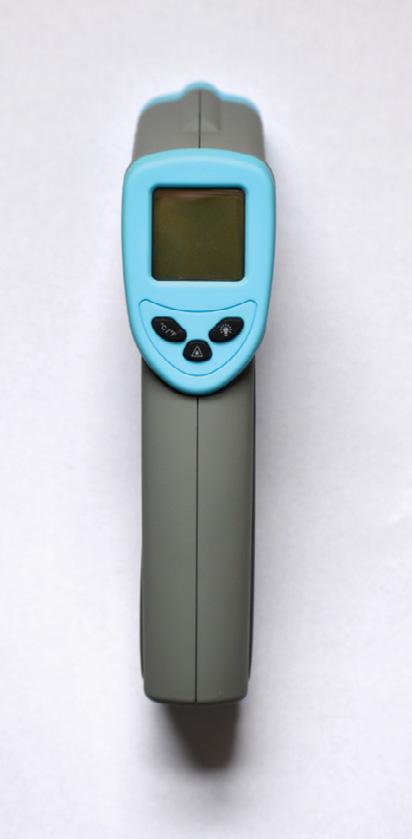

Squeeze this button to take the temperature.


Lasers and Eyeballs: What’s the Big Deal?
You’ve been told over and over again, don’t focus a laser directly in someone’s eyes. But why is this an issue? The reason is because laser light is unlike most light with which you are familiar. The word laser is an acronym, meaning Light Amplification by Stimulated Emission of Radiation. In a nutshell, lasers are produced when specific substances are energized, and the laser light is the result. Lasers are intense for two reasons. First, the light from a laser is only one wavelength, or color, of light. Most light sources you see, even colored bulbs, are a range of wavelengths. Lasers emit only one specific wavelength. Second, the light from a laser is focused and aligned and can be directed across great distances, even to the moon! Because of the intensity of the light from a laser, it can at best cause “flash blindness” and temporarily blind a person, and at worst can cause permanent damage to the retina, the part of the eye that detects light and transmits the light information to the nerves in the eye.
©2024 The NEED Project School Energy Experts Teacher Guide www.NEED.org 43
Left
Right
Back View Front View
Side
Side
Button Backlight Button Laser Selector Button
Transporting Electricity
Explain what each of the components numbered below does to get electricity from the generator to the consumer.
44 ©2024 The NEED Project School Energy Experts Teacher Guide www.NEED.org
1 2 4 3 5 6 7
Kill A Watt® Meter
The Kill A Watt® meter allows users to measure and monitor the power consumption of any standard electrical device. You can obtain instantaneous readings of voltage (volts), current (amps), line frequency (Hz), and electric power being used (watts). You can also obtain the actual amount of power consumed in kilowatt-hours (kWh) by any electrical device over a period of time from one minute to 9,999 hours. A kilowatt is 1,000 watts.
Operating Instructions
1. Plug the Kill A Watt® meter into any standard grounded outlet or extension cord.
2. Plug the electrical device or appliance to be tested into the AC Power Outlet Receptacle of the Kill A Watt® meter.
3. The LCD displays all meter readings. The unit will begin to accumulate data and powered duration time as soon as the power is applied.
4. Press the Volt button to display the voltage (volts) reading.
5. Press the Amp button to display the current (amps) reading.
6. The Watt and VA button is a toggle function key. Press the button once to display the Watt reading; press the button again to display the VA (volts x amps) reading. The Watt reading, not the VA reading, is the value used to calculate kWh consumption.
7. The Hz and PF button is a toggle function key. Press the button once to display the Frequency (Hz) reading; press the button again to display the Power Factor (PF) reading.
8. The KWH and Hour button is a toggle function key. Press the button once to display the cumulative energy consumption. Press the button again to display the cumulative time elapsed since power was applied.
What is Power Factor?
The formula Volts x Amps = Watts is used to find the energy consumption of an electrical device. Many AC devices, however, such as motors and magnetic ballasts, do not use all of the power provided to them. The Power Factor (PF) has a value equal to or less than one, and is used to account for this phenomenon. To determine the actual power consumed by an AC device, the following formula is used:
Volts x Amps x PF = Watts Consumed

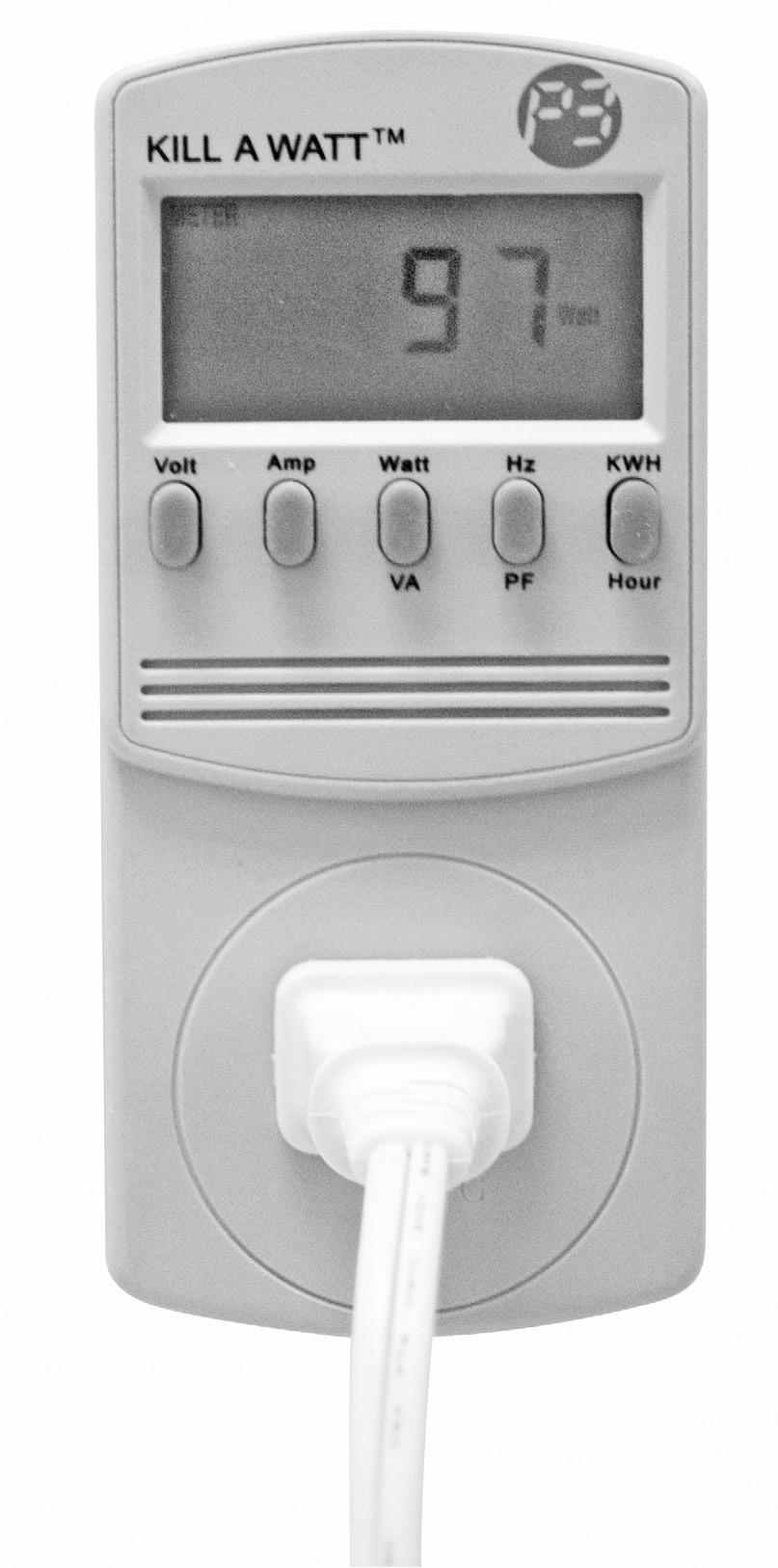
©2024 The NEED Project School Energy Experts Teacher Guide www.NEED.org 45
The Light Meter
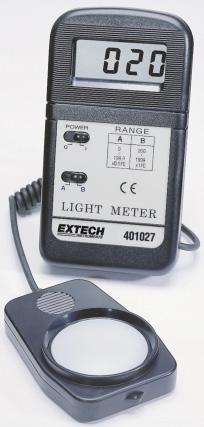
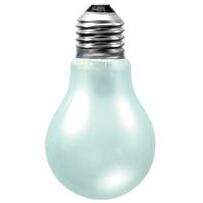
Operating Instructions
1. Insert the battery into the battery compartment in the back of the meter.
2. Slide the ON/OFF Switch to the ON position.
3. Slide the Range Switch to the B position.
4. On the back of the meter, pull out the meter’s tilt stand and place the meter on a flat surface in the area you plan to measure.
5. Hold the Light Sensor so that the white lens faces the light source to be measured or place the Light Sensor on a flat surface facing the direction of the light source.
6. Read the measurement on the LCD Display.
7. If the reading is less than 200 fc, slide the Range Switch to the A position and measure again.
Light Output or Luminous Flux
A lumen (lm) is a measure of the light output (or luminous flux) of a light source (bulb or tube). Light sources are labeled with output ratings in lumens. A T12 40-watt fluorescent tube light, for example, may have a rating of 3050 lumens.
Light Level or Illuminance
A foot-candle (fc) is a measure of the quantity of light (illuminance) that actually reaches the workplane on which the light meter is placed. Foot-candles are workplane lumens per square foot. The light meter can measure the quantity of light from 0 to 1000 fc.
Brightness or Luminance
Another measure of light is its brightness or luminance. Brightness is a measure of the light that is reflected from a surface in a particular direction. Brightness is measured in footlamberts (fL).
46 ©2024 The NEED Project School Energy Experts Teacher Guide www.NEED.org
LCD Display ON/OFF Switch Range Switch Light Sensor
Digital Thermometer
A digital thermometer measures the temperature of a substance and displays the temperature reading on its face. It has a battery for power. Sometimes they are waterproof for measuring the temperature of a liquid.
This digital thermometer can measure the temperature in Fahrenheit or Celsius. It shows the temperature range of the thermometer. It can read temperatures from -40° to 392°F and -40° to 200°C.
It has three buttons. The button on the bottom left is the ON/ OFF switch. If the thermometer is not used for a few minutes, it turns itself off.
The C/F button on the bottom right switches from the Celsius scale to the Fahrenheit scale. The face of the thermometer will show a C or an F to indicate which scale is being used.
The mode button on the top holds the temperature reading when it is pushed. If you need the exact temperature of a liquid, you push the hold button while the thermometer is in the liquid, then remove the thermometer to read it. This button will also allow you to view the maximum and minimum temperatures measured when pushed two or three times.
The metal stem of the thermometer can measure the temperature of the air or the temperature of a liquid. The stem should be placed about halfway into a liquid to measure the temperature.
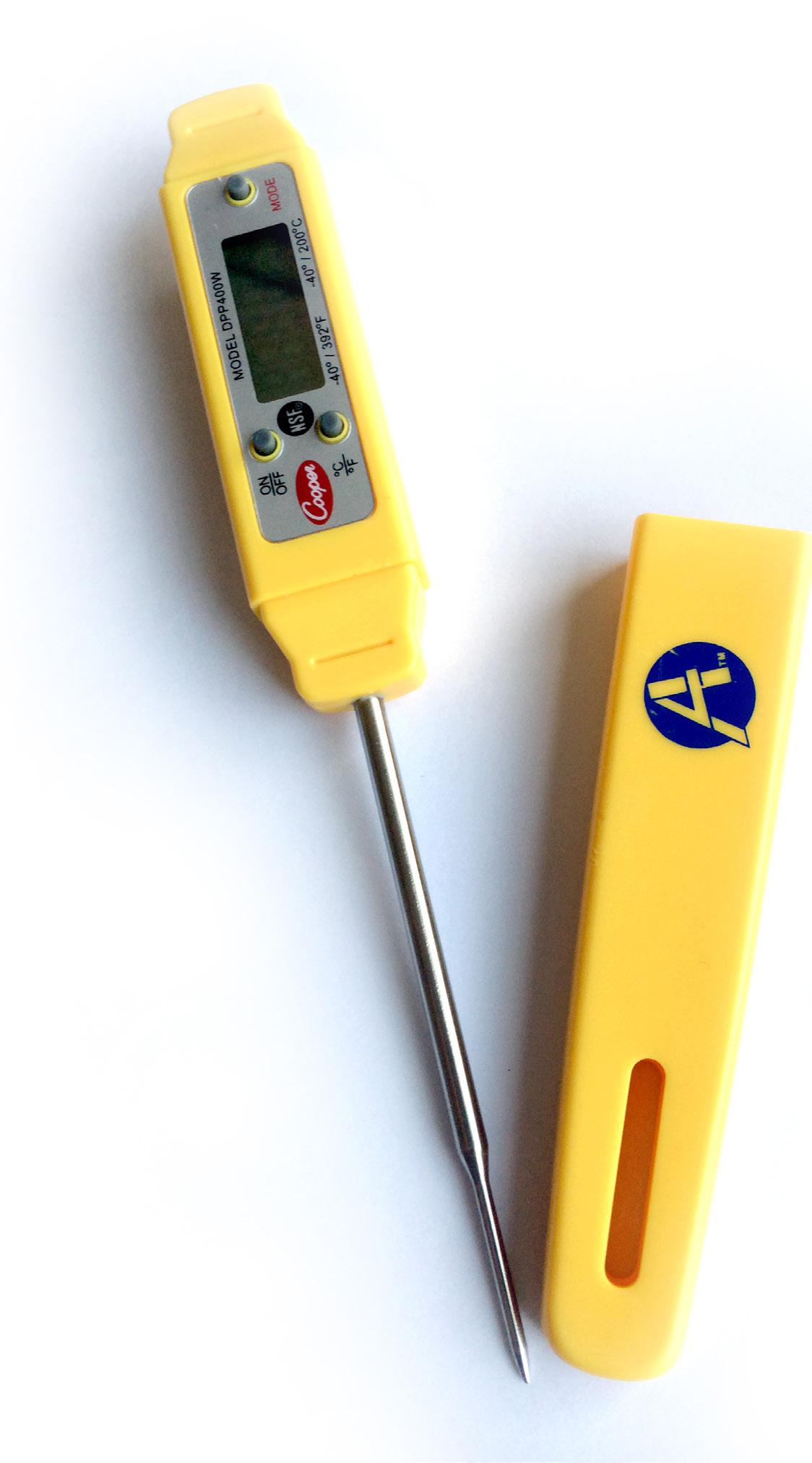
©2024 The NEED Project School Energy Experts Teacher Guide www.NEED.org 47
Hygrometer
HUMIDITY/TEMPERATURE
PEN
Scientists measure the amount of water vapor in the air in terms of relative humidity—the amount of water vapor in the air relative to (compared to) the maximum amount it can hold at that temperature. Relative humidity changes as air temperature changes. The warmer the air is, the more water vapor it can hold.
Air acts like a sponge and absorbs water through the process of evaporation. Warm air is less dense and the molecules are further apart, allowing more moisture between them. Cooler air causes the air molecules to draw closer together, limiting the amount of water the air can hold.
It is important to control humidity in occupied spaces. Humidity levels that are too high can contribute to the growth and spread of unhealthy biological pollutants. This can lead to a variety of health effects, from common allergic reactions to asthma attacks and other health problems. Humidity levels that are too low can contribute to irritated mucous membranes, dry eyes, and sinus discomfort.
This digital humidity/temperature pen measures relative humidity and temperature and displays the readings on its face. It has a battery for power. It can display the temperature in Fahrenheit or Celsius. The reading shown on the right is 68.5°F. Devices that measure humidity are also called hygrometers.
The hygrometer displays relative humidity in terms of percentage. The hygrometer shown reads 35%. This means that the air contains 35 percent of the water vapor it can hold at the given air temperature. When the air contains a lot of water vapor, the weather is described as humid. If the air cannot carry any more water vapor, the humidity is 100 percent. At this point, the water vapor condenses into liquid water.
Maintaining relative humidity between 40 and 60 percent helps control mold. Maintaining relative humidity levels within recommended ranges is a way of ensuring that a building’s occupants are both comfortable and healthy. High humidity is uncomfortable for many people. It is difficult for the body to cool down in high humidity because sweat cannot evaporate into the air.

Directions ON/OFF KEY
Press the ON/OFF key to turn the power on or off.
°F/°C
Press the °F/°C key to select the temperature unit you want to use, Fahrenheit or Celsius.
MAX/MIN
Press the MAX/MIN key once to display the stored maximum readings for temperature and humidity.
An up arrow will appear on the left side of the display to indicate the unit is in the maximum recording mode.
Press the MAX/MIN key a second time to display the stored minimum readings for temperature and humidity. A down arrow will appear on the left side of the display to indicate the unit is in the minimum recording mode.
Press the MAX/MIN key a third time to return to normal operation.
CLEAR
If an up or down arrow is displayed, press the CLEAR key until - - - appears on the display. The memory is cleared. New maximum or minimum values will be recorded within 3 seconds.
48 ©2024 The NEED Project School Energy Experts Teacher Guide www.NEED.org

ENERGY EFFICIENCY
A. Can name two ways to increase a car’s MPG
E. Knows the definition of energy efficiency
I. Knows a type of bulb that uses one-quarter of the energy of incandescents
M. Sets this item differently at day and night and for the season
B. Can name three ways to save energy at home
F. Knows the definition of energy conservation
J. Knows where to find an EnergyGuide label
N. Knows the number one use of energy in the home
BINGO
C. Can name three ways to save energy at school
G. Knows what an ENERGY STAR® label means
K. Can name one appliance that should be run only when fully loaded
O. Has an energy conservation team at school
D. Has at least one ENERGY STAR® appliance at home
H. Knows what SEER is
L. Uses day lighting in the classroom instead of overhead lights
P. Knows whether energy is the first, second, or third highest expenditure in a school district (choose one)
©2024 The NEED Project School Energy Experts Teacher Guide www.NEED.org 49
NAME NAME NAME NAME NAME NAME NAME NAME NAME NAME NAME NAME NAME NAME NAME NAME A E I M B F J N C G K O D H L P
OFF
I have kilowatt-hour.
Who has a light bulb that produces more heat than light?
I have an incandescent.
Who has energy is neither created nor destroyed?
I have the Law of Conservation of Energy.
Who has the number one use of energy in the home?
I have heating and cooling.
I have landscaping.
Who has the most effective way for consumers to reduce the amount of energy used by industry?
I have reduce, reuse, repair, recycle.
Who has any behavior that results in using less energy?
I have conservation.
Who has the length of time you use an energy efficient appliance before you begin to save money?
Who has the label designating energy efficient home appliances? I have payback period.
Who has the nation’s leading recycled product?
I have ENERGY STAR ®.
Who has a way to reduce energy use by planting trees to block wind and provide shade?
I have steel.
Who has a material that resists the flow of heat?
50 ©2024 The NEED Project School Energy Experts Teacher Guide www.NEED.org
I have insulation.
Who has a way to use gasoline more efficiently?
I have keep tires properly inflated.
Who has solar, hydropower, geothermal, biomass, and wind?
I have renewables.
Who has a light bulb that uses less than one-fourth the energy of an old-fashioned incandescent bulb?
I have a light emitting diode (LED).
Who has the leading source of air pollution?
I have energy efficiency.
Who has a digital meter installed in your home that communicates with your utility company to monitor and control energy usage?
I have Smart Meter.
Who has a way to learn how a building can use energy more efficiently?
I have energy audit.
Who has the label that shows an appliance’s annual energy use and operating cost?
I have EnergyGuide.
Who has the flow of electrons?
I have vehicle emissions.
Who has using technology that needs less energy to perform the same function?
I have electricity.
Who has caulking, sealing, and weatherstripping cracks around doors and windows?
©2024 The NEED Project School Energy Experts Teacher Guide www.NEED.org 51
I have ways to reduce air infiltration.
Who has an alternative mode of transportation?
I have riding a bicycle.
Who has the concept that a society should meet its energy needs without compromising the needs of future generations?
I have take short showers. Who has an energy intensive industry?
I have energy sustainability.
Who has the sector of the economy that uses the most petroleum?
I have petroleum refining.
Who has a device that allows you to control the temperature in your home?
I have programmable thermostat.
Who has a renewable transportation fuel?
I have transportation.
Who has the kitchen appliance that uses the most energy?
I have ethanol.
Who has a nonrenewable energy source that is used to generate electricity?
I have refrigerator.
Who has a way to reduce the cost of heating water?
I have natural gas. Who has a measure of electricity consumption?
52 ©2024 The NEED Project School Energy Experts Teacher Guide www.NEED.org
Youth Energy Conference & Awards
The NEED Youth Energy Conference and Awards gives students more opportunities to learn about energy and to explore energy in STEM (science, technology, engineering, and math). The annual June conference has students from across the country working in groups on an Energy Challenge designed to stretch their minds and energy knowledge. The conference culminates with the Youth Awards Ceremony recognizing student work throughout the year and during the conference.
For More Info: www.need.org/youthenergyconference/
Youth AWards Program for Energy Achievement
All NEED schools have outstanding classroom-based programs in which students learn about energy. Does your school have student leaders who extend these activities into their communities? To recognize outstanding achievement and reward student leadership, The NEED Project conducts the National Youth Awards Program for Energy Achievement.
Share Your Energy Outreach with The NEED Network! This program combines academic competition with recognition to acknowledge everyone involved in NEED during the year—and to recognize those who achieve excellence in energy education in their schools and communities.
What’s involved?
Students and teachers set goals and objectives and keep a record of their activities. Students create a digital project to submit for judging. In April, digital projects are uploaded to the online submission site.
Check out:
https://youthawards.need.org/project-guidelines/ for more project and application information. Be sure to explore the remainder of the site to learn more about the Awards weekend, see past winner sample projects, and more!
©2024 The NEED Project School Energy Experts Teacher Guide www.NEED.org 53
ORDER MATERIALS AND CURRICULUM ONLINE!
Anemometers and solar cells and light meters — oh my! Getting your guides and kits (or refills) has never been easier! Check out NEED’s official online store at NEED.org/shop.
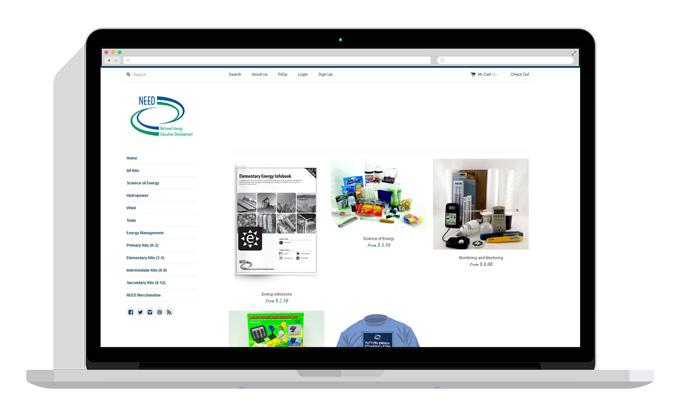

54 Teacher Guide www.NEED.org
School Energy Experts Evaluation Form
1. Did you conduct the entire unit?
2. Were the instructions clear and easy to follow?
3. Did the activities meet your academic objectives?
4. Were the activities age appropriate?
5. Were the allotted times sufficient to conduct the activities?
6. Were the activities easy to use?
Yes
No
7. Was the preparation required acceptable for the activities? Yes
8. Were the students interested and motivated?
9. Was the energy knowledge content age appropriate?
10. Would you teach this unit again?
Please explain any ‘no’ statement below.
What would make the unit more useful to you?
Yes
Yes
No
No
No
No
Other Comments:
©2024 The NEED Project School Energy Experts Teacher Guide www.NEED.org 55
Grade
__________
State: ___________
Level: ___________ Number of Students:
Yes
No
Yes
No
Yes
No
Yes
No
Yes
No
Yes
unit overall? excellent good fair poor
unit overall? excellent good fair poor
How would you rate the
How would your students rate the
Please
to: The NEED Project 8408 Kao Circle FAX: 1-800-847-1820 Manassas, VA 20110 Email: info@need.org
fax or mail
AES
AES Clean Energy Development
American Electric Power Foundation
Appalachian Voices
Arizona Sustainability Alliance
Atlantic City Electric
Baltimore Gas & Electric
Berkshire Gas - Avangrid
BP America Inc.
Bob Moran Charitable Giving Fund
Cape Light Compact–Massachusetts
Celanese Foundation
Central Alabama Electric Cooperative
CITGO
The City of Cuyahoga Falls
Clean Virginia CLEAResult
ComEd
Con uence
ConocoPhillips
Constellation
Delmarva Power and Light
Department of Education and Early Childhood
Development - Government of New Brunswick, Canada
Dominion Energy, Inc.
Dominion Energy Charitable Foundation
DonorsChoose
East Baton Rouge Parish Schools
East Kentucky Power Cooperative
EcoCentricNow
EDP Renewables
EduCon Educational Consulting
Enel Green Power North America
ENGIE
Entergy
Equinix
Eversource
Exelon
Exelon Foundation
Foundation for Environmental Education
FPL
Generac
Georgia Power
Gerald Harrington, Geologist
Government of Thailand–Energy Ministry
Greater New Orleans STEM
GREEN Charter Schools
Green Power EMC
Guilford County Schools–North Carolina
Honeywell
National Sponsors and Partners
Iowa Governor’s STEM Advisory Council -
Scale Up
Iowa Lakes Community College
Iowa State University
Illinois Clean Energy Community Foundation
Illinois International Brotherhood of Electrical
Workers Renewable Energy Fund
Independent Petroleum Association of New Mexico
Intuit
Iron Mountain Data Centers
Kansas Corporation Energy Commission
Kansas Energy Program – K-State Engineering
Extension
Katy Independent School District
Kentucky Environmental Education Council
Kentucky O ce of Energy Policy
Kentucky Power–An AEP Company
Liberty Utilities
Llano Land and Exploration
Louisiana State Energy O ce
Louisiana State University – Agricultural Center
LUMA
Marshall University
Mercedes Benz USA
Minneapolis Public Schools
Mississippi Development Authority–Energy Division
Motus Experiential
National Fuel
National Grid
National Hydropower Association
National Ocean Industries Association
National Renewable Energy Laboratory
NC Green Power
Nebraskans for Solar
NextEra Energy Resources
Nicor Gas
NCi – Northeast Construction
North Shore Gas
O shore Technology Conference
Ohio Energy Project
Oklahoma Gas and Electric Energy Corporation
Omaha Public Power District
Ormat
Paci c Gas and Electric Company
PECO
Peoples Gas
Pepco
Performance Services, Inc.
Permian Basin Petroleum Museum
Phillips 66
PowerSouth Energy Cooperative
PPG
Prince George’s County O ce of Human Resource Management (MD)
Prince George’s County O ce of Sustainable Energy (MD)
Providence Public Schools
Public Service of Oklahoma - AEP
Quarto Publishing Group
The Rapha Foundation
Renewable Energy Alaska Project
Rhoades Energy
Rhode Island O ce of Energy Resources
Salal Foundation/Salal Credit Union
Salt River Project
Salt River Rural Electric Cooperative
Schneider Electric
C.T. Seaver Trust
Secure Solar Futures, LLC
Shell USA, Inc.
SMUD
Society of Petroleum Engineers
South Carolina Energy O ce
Southern Company Gas
Snohomish County PUD
SunTribe Solar
TXU Energy
United Way of Greater Philadelphia and Southern New Jersey
Unitil
University of Iowa
University of Louisville
University of North Carolina
University of Northern Iowa
University of Rhode Island
U.S. Department of Energy
U.S. Department of Energy–O ce of Energy
E ciency and Renewable Energy
U.S. Department of Energy - Solar Decathlon
U.S. Department of Energy - Water Power
Technologies O ce
U.S. Department of Energy–Wind for Schools
U.S. Energy Information Administration
United States Virgin Islands Energy O ce
Virginia Cooperative Extension
Vistra Energy
We Care Solar
West Virginia O ce of Energy
West Warwick Public Schools
©2024 The NEED Project 8408 Kao Circle, Manassas, VA 20110 1.800.875.5029 www.NEED.org
































